Belkin F5D7633-4 ADSL Modem with High-Speed Mode Wireless-G Router User Manual P74730uk F5D7633uk4 man indd
Belkin International, Inc. ADSL Modem with High-Speed Mode Wireless-G Router P74730uk F5D7633uk4 man indd
Belkin >
Contents
- 1. Part 1
- 2. Part 2
Part 1

1
Introduction
1
2
1
3
4
5
6
7
8
9
10
11
12
section
Thank you for purchasing the Belkin ADSL Modem with High-Speed
Mode Wireless G Router (the Router). In minutes you will be able to
share your Internet connection and network your computers with your
new Router. The following is a list of features that make your Router an
ideal solution for your home or small office network. Please be sure to
read through this User Manual completely, and pay special attention to
Appendix B entitled “Important Factors for Placement and Setup”.
Product Features
Compatibility with Both PCs and Mac® Computers
The Router supports a variety of networking environments including
Mac OS® 8.x, 9.x, X v10.x, AppleTalk®, Linux®, Windows® 95, 98SE,
Me, NT®, 2000, and XP, and others. You need an Internet browser
and a network adapter that supports TCP/IP (the standard language
of the Internet).
Front-Panel LED Display
Lighted LEDs on the front of the Router indicate which functions
are in operation. You’ll know at-a-glance whether your Router is
connected to the Internet. This feature eliminates the need for
advanced software and status-monitoring procedures.
Web-Based Advanced User Interface
You can set up the Router’s advanced functions easily through your
web browser, without having to install additional software onto the
computer. There are no disks to install or keep track of and, best
of all, you can make changes and perform setup functions from any
computer on the network quickly and easily.
Integrated 10/100 4-Port Switch
The Router has a built-in, 4-port network switch to allow your wired
computers to share printers, data and MP3 files, digital photos,
and much more. The switch features automatic detection so it will
adjust to the speed of connected devices. The switch will transfer
data between computers and the Internet simultaneously without
interrupting or consuming resources.
Integrated 802.11g Wireless Access Point
802.11g is an exciting new wireless technology that achieves data
rates up to 54Mbps, nearly five times faster than 802.11b.

32
Introduction
3
Introduction
125 High-Speed Mode
High-Speed Mode (HSM)*, a 54g™ performance enhancement,
provides the fastest wireless connectivity for 802.11g-capable
networks in real-world environments. It is designed for home networks
that require additional bandwidth for applications such as sharing
digital pictures. 125HSM makes 802.11g WLANs more efficient
without impacting the performance of neighboring networks, and it is
compatible at high speeds with leading brands.
Built-In Dynamic Host Configuration Protocol (DHCP)
Built-In Dynamic Host Configuration Protocol (DHCP) on-board makes
for the easiest possible connection of a network. The DHCP server
will assign IP addresses to each computer automatically so there is no
need for a complicated networking setup.
NAT IP Address Sharing
Your Router employs Network Address Translation (NAT) to share the
single IP address assigned to you by your Internet Service Provider
while saving the cost of adding additional IP addresses to your
Internet service account.
SPI Firewall
Your Router is equipped with a firewall that will protect your network
from a wide array of common hacker attacks including IP Spoofing,
Land Attack, Ping of Death (PoD), Denial of Service (DoS), IP with zero
length, Smurf Attack, TCP Null Scan, SYN flood, UDP flooding, Tear
Drop Attack, ICMP defect, RIP defect, and fragment flooding.
MAC Address Filtering
For added security, you can set up a list of MAC addresses (unique client
identifiers) that are allowed access to your network. Every computer has its
own MAC address. Simply enter these MAC addresses into a list using the
web-based user interface and you can control access to your network.
Universal Plug-and-Play (UPnP) Compatibility
UPnP (Universal Plug-and-Play) is a technology that offers seamless
operation of voice messaging, video messaging, games, and other
applications that are UPnP-compliant.
Support for VPN Pass-Through
If you connect to your office network from home using a VPN
connection, your Router will allow your VPN-equipped computer to
pass through the Router and to your office network.

32
Introduction
Introduction
3
Introduction
2
1
3
4
5
6
7
8
9
10
11
12
section
*When operating in High-Speed Mode, this Wi-Fi® device may achieve
an actual throughput of up to or greater than 34.1Mbps, which is the
equivalent throughput of a system following 802.11g protocol and
operating at a signaling rate of 125Mbps. Actual throughput will vary
depending on environmental, operational, and other factors.
Benefits of a Home Network
By following our simple setup instructions, you will be able to use
your Belkin home network to:
• Share one high-speed Internet connection with all the computers
in your home
• Share resources, such as files, and hard drives among all the
connected computers in your home
• Share a single printer with the entire family
• Share documents, music, video, and digital pictures
• Store, retrieve, and copy files from one computer to another
• Simultaneously play games online, check Internet email,
and chat
Advantages of a Belkin Wireless Network
Mobility – you’ll no longer need a dedicated “computer room”— now you
can work on a networked laptop or desktop computer anywhere within
your wireless range
Easy installation –
Belkin’s Easy Installation Wizard makes setup simple
Flexibility – set up and access printers, computers, and other
networking devices from anywhere in your home
Easy Expansion – the wide range of Belkin networking products let
you expand your network to include devices such as printers and
gaming consoles
No cabling required – you can spare the expense and hassle of
retrofitting Ethernet cabling throughout the home or office
Widespread industry acceptance – choose from a wide range of
interoperable networking products

54
5
Package Contents
• ADSL Modem with High-Speed Mode Wireless G Router
• RJ11 Telephone Cord - Gray
• RJ45 Ethernet Networking Cable - Yellow
• ADSL Microfilter*
• Power Adapter
• User Manual CD
*ADSL microfilter varies by country. If it’s not included, you will need to
purchase one.
System Requirements
• An active ADSL service with a telephone wall jack for connecting
the Router
• At least one computer with a Network Interface Card (NIC) and Internet
browser installed and correctly configured
• TCP/IP networking protocol installed on each computer connected to
the Router
• No other DHCP server on your local network assigning IP addresses to
computers and devices
Internet Connection Settings
Please collect the following information from your Internet Service Provider
(ISP) before setting up the ADSL Modem Wireless G Router.
• Internet connection protocol: _________ (PPPoE, PPPoA, Dynamic IP,
Static IP)
• Multiplexing method or Encapsulation: __________ (LLC or VC MUX)
• Virtual circuit: VPI (Virtual Path Identifier) __________
(a number between 0 and 255)
• VCI (Virtual Channel Identifier) __________
(a number between 1 and 65535)
• For PPPoE and PPPoA users: ADSL account user name _____________
and password _______________
• For static IP users: IP Address ___ . ___ . ___
Subnet Mask ___ . ___ . ___
Default Gateway Server ___ . ___ . ___ .
• IP address for Domain Name Server ___ . ___ . ___ . ___ (If given by
your ISP)
Note: See Appendix C in this User Manual for some common DSL
Internet setting parameters. If you are not sure, please contact your ISP.
Make Sure You Have the Following
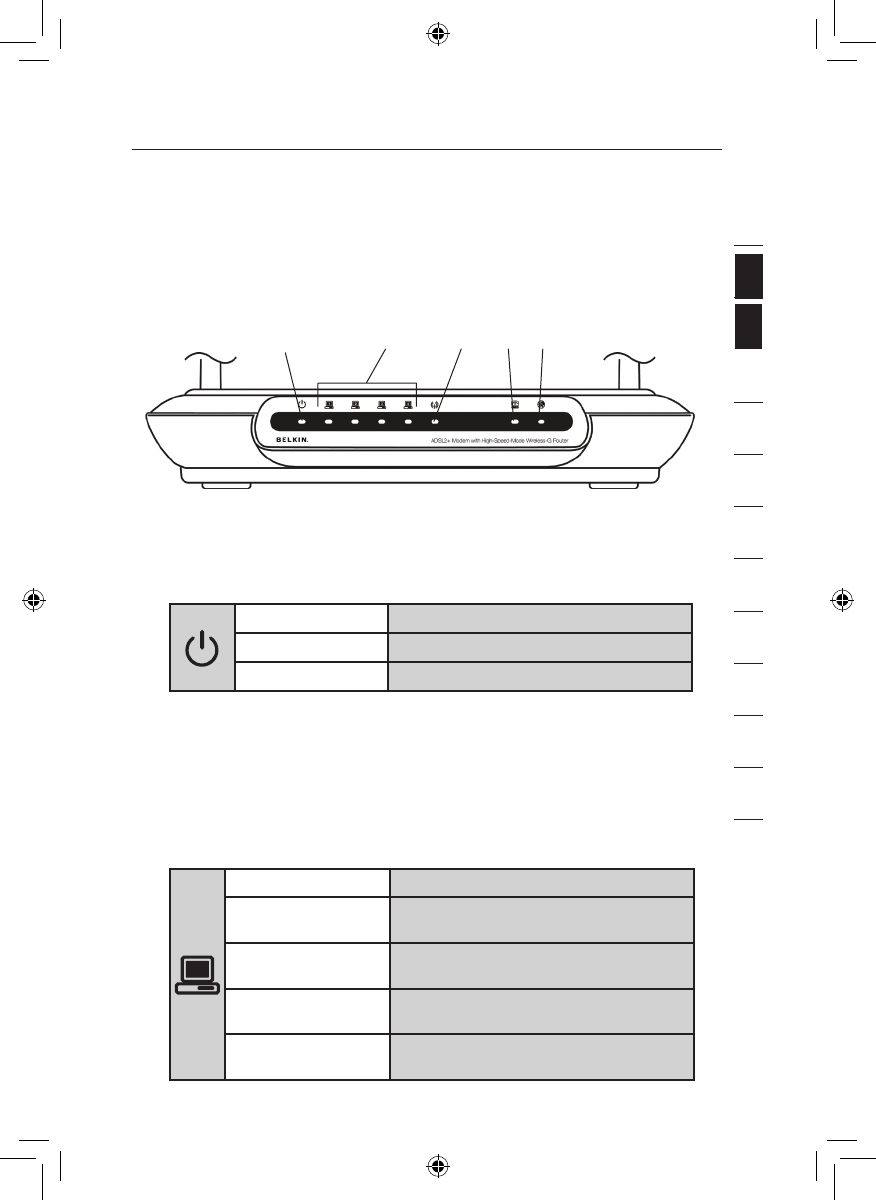
54
Knowing your Router
5
The Router is designed to be placed on a desktop. All of the cables
exit from the rear of the Router for better organization and utility. The
LED indicators are easily visible on the front of the Router to provide
you with information about network activity and status.
Front Panel
1. Power LED
When you apply power to the Router or restart it, a short period
of time elapses while the Router boots up. When the Router has
completely booted up, the Power LED becomes a SOLID light,
indicating the Router is ready for use.
OFF Router is OFF
Green Router is ON
Red Router failed to start
2. LAN Status LED
These LAN Status LEDs are labeled 1–4 and correspond to the
numbered ports on the rear of the Router. When a computer is
properly connected to one of the LAN ports on the rear of the
Router, the LED will light. Solid GREEN means a computer or a
network-enabled device is connected. When information is being
sent over the port, the LED blinks rapidly. ORANGE indicates a
10Base-T connection.
OFF Your device is connected
Orange Ethernet link is up and 10Base-T
device connected
Orange - blinking When 10Base-T device transmitting
or receiving data
Green Ethernet link is up and
100Base-T connected
Green - blinking When 100Base-T device
transmitting or receiving data
(1) (4) (3)(5)(2)
section
2
1
3
4
5
6
7
8
9
10
11
12
Make Sure You Have the Following
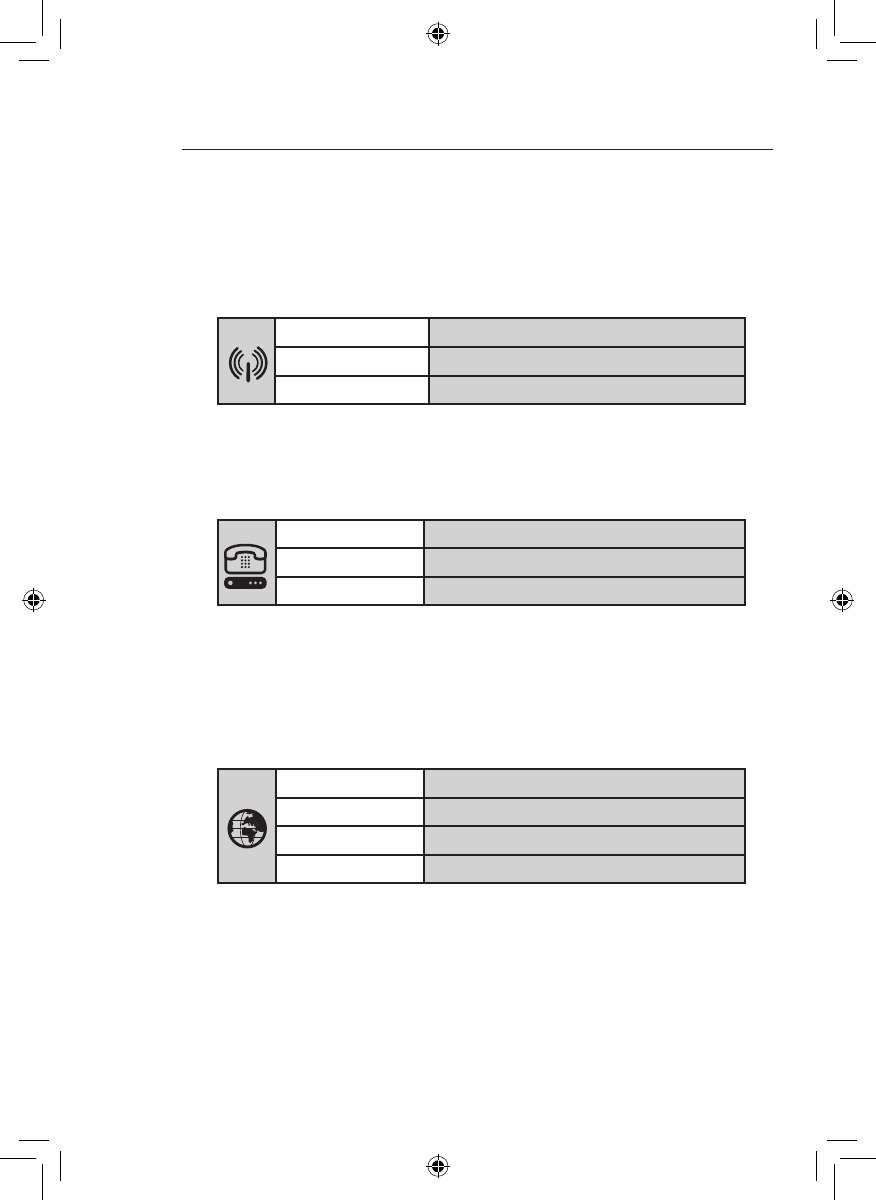
76
Knowing your Router
7
3. WLAN Status LED
The WLAN Status LED is solid GREEN when you enable the
wireless LAN function. It flashes when the Router is transmitting
or receiving data wirelessly.
OFF WLAN is off
Green WLAN is up and connected
Green - blinking When transmitted or receiving data
4. ADSL LED
The ADSL LED flashes GREEN during negotiation with your ISP.
It stays GREEN when the Router is connected properly to your
ADSL service.
OFF no ADSL connection
Green ADSL link is up and connected
Green - blinking negotiating connection
5. Internet LED
The Internet LED shows you when the Router is connected to
the Internet. When the LED is OFF, the Router is NOT connected
to the Internet. When the LED is solid GREEN, the Router is
connected to the Internet. When the LED is blinking, the Router
is transmitting or receiving data from the Internet.
OFF No Internet connection
Green Connected to the Internet
Green - blinking When transmitting or receiving data
Red Failed to get IP
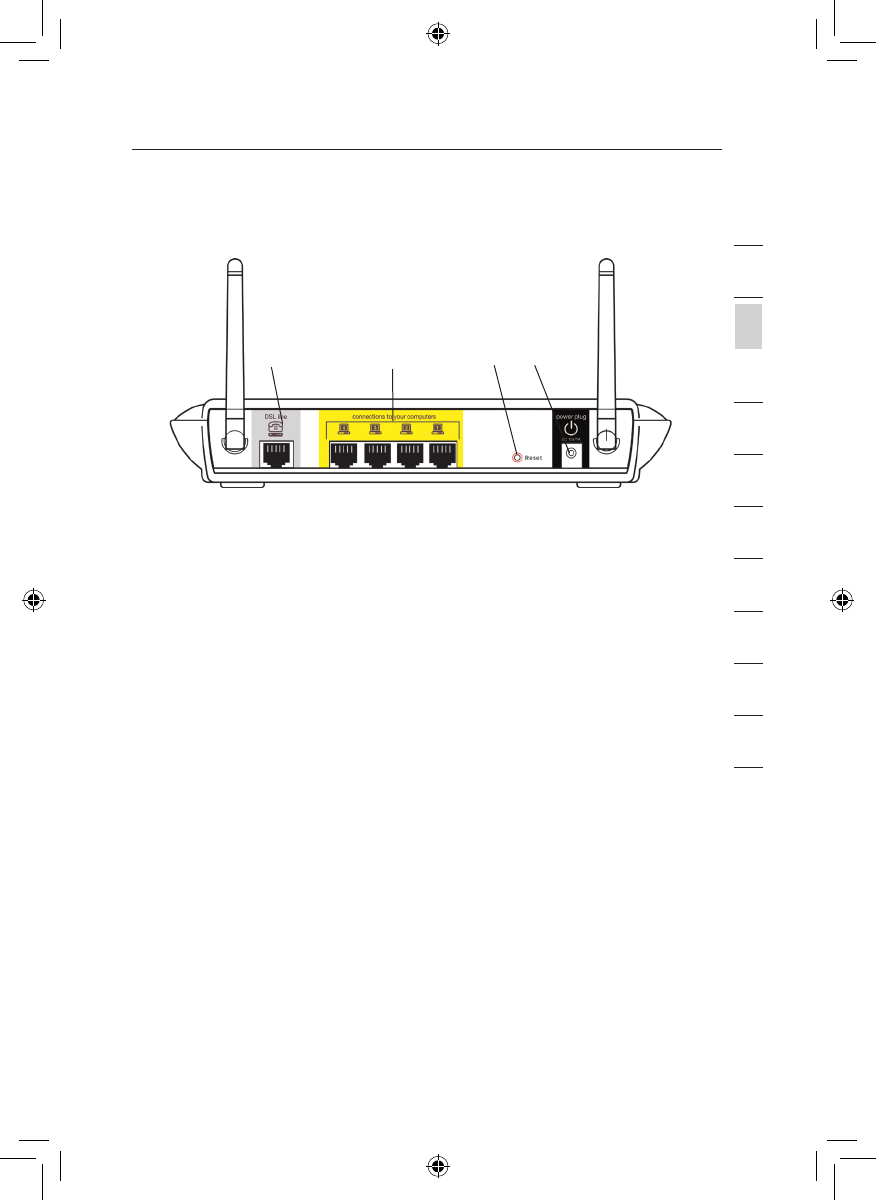
76
Knowing your Router
Knowing your Router
7
section
2
1
3
4
5
6
7
8
9
10
11
12
Back Panel
6. DSL Line
This port is for connection to your ADSL line. Connect your ADSL
line to this port.
7. Ethernet Ports
The Ethernet ports are RJ45, 10/100 auto-negotiation. The ports
are labeled 1 through 4. These ports correspond to the numbered
LEDs on the front of the Router. Connect your network-enabled
computers or any networking devices to one of these ports.
8. Reset Button
The “Reset” button is used in rare cases when the Router may
function improperly. Resetting the Router will restore the Router’s
normal operation while maintaining the programmed settings. You
can also restore the factory default settings by using the Reset
button. Use the restore option in instances where you may have
forgotten your custom password.
a. Resetting the Router
Push and hold the Reset button for one second then release
it. When the Power/Ready light becomes solid again, the
reset is complete.
b. Restoring the Factory Defaults
Press and hold the Reset button for five seconds then
release it. When the Power/Ready light becomes solid again,
the restore is complete.
9. Power Plug
Connect the included 15V DC power supply to this inlet.
Using the wrong type of power adapter may cause damage
to your Router.
(7) (8) (9)
(6)

98
Connecting your Router
9
Positioning your Router
Your wireless connection will be stronger the closer your computer
is to your Router. Typical indoor operating range for your wireless
devices is between 100 and 200 feet. In the same way, your wireless
connection and performance will degrade somewhat as the distance
between your Router connected devices increases. This may or may
not be noticeable to you. As you move farther from your Router,
connection speed may decrease. Factors that can weaken signals
simply by getting in the way of your network’s radio waves are metal
appliances, or obstructions, and walls. Please see “Appendix B:
Important Factors for Placement and Setup” in this User Manual for
more guidelines.
If you have concerns about your network’s performance that might be
related to range or obstruction factors, try moving the computer to
a position between five and 10 feet from the Router, in order to see
if distance is the problem. If difficulties persist even at close range,
please see the Troubleshooting section for solutions.
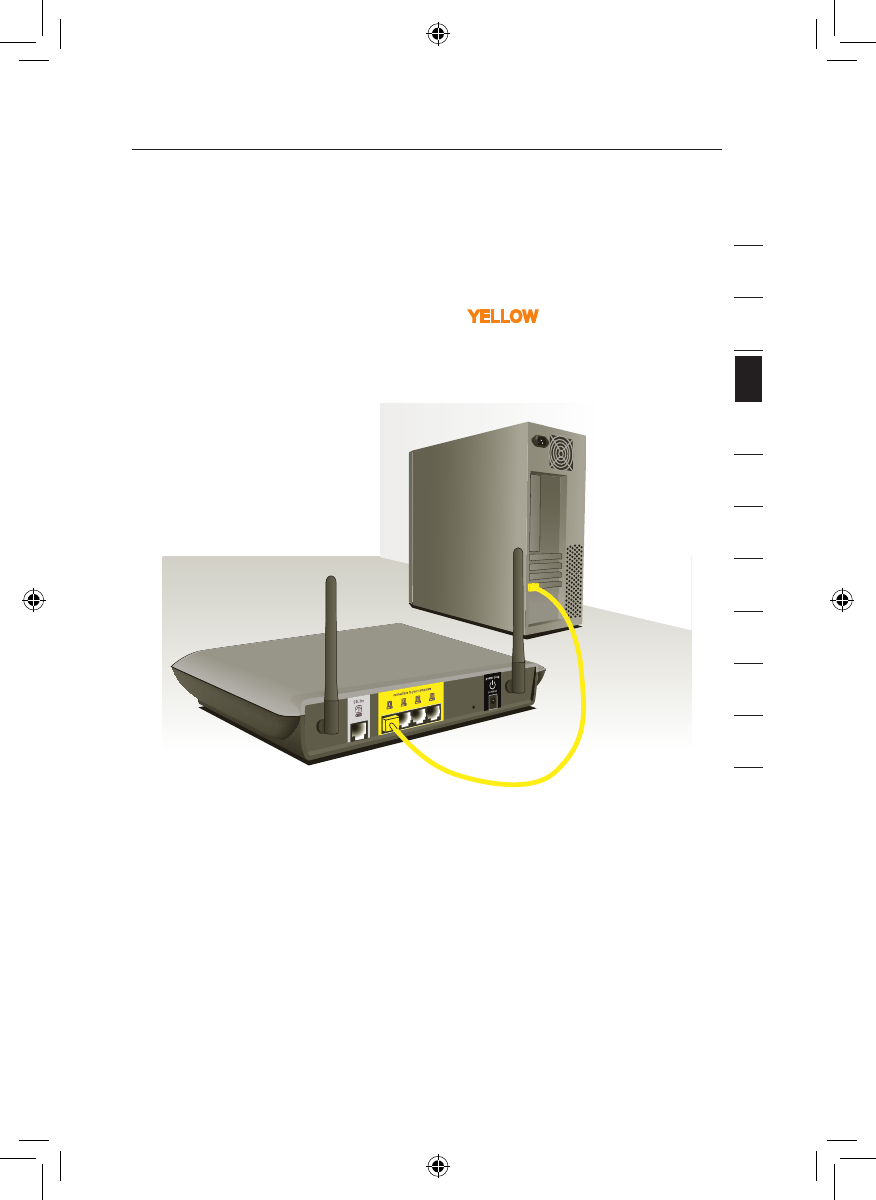
98
Connecting your Router
Connecting your Router
9
section
2
1
3
4
5
6
7
8
9
10
11
12
Connecting your Computers
1. Power off your computers and networking equipment.
2. Connect your computer to one of the YELLOW RJ45 ports on the
rear of the Router labeled “connections to your computers” by
using an Ethernet networking cable (one Ethernet network cable
is supplied).

1110
Connecting your Router
11
Connecting your ADSL Line
Connection for the Router to the ADSL line varies by country and
region. Typically it involves a microfilter or a microfilter with built-in
splitter to allow simultaneous use of ADSL service and telephone
service on the same telephone line. Please read the following steps
carefully and select appropriate method.
1. If your telephone service and ADSL service are on the same
telephone line, ADSL microfilters are needed for each telephone
and device, such as answering machine, fax machine, and caller
ID display. Additional splitters may be used to separate telephone
lines for telephone and the Router.
Note: Do not connect the ADSL microfilter between the wall jack
and the Router—this will prevent ADSL service from reaching
the modem.
2. If your telephone service and ADSL service are on the same
telephone line and you are using an ADSL microfilter with built-in
splitter, connect the splitter to the telephone wall jack providing
ADSL service. Then, connect the telephone cord from the ADSL
microfilter RJ11 port generally labeled “DSL” to the gray RJ11
port labeled “DSL line” on the back of your Router. Connect
telephony device to the other port on the ADSL splitter commonly
labeled “Phone”. An additional ADSL microfilter is needed for
another telephone and device on the same line.
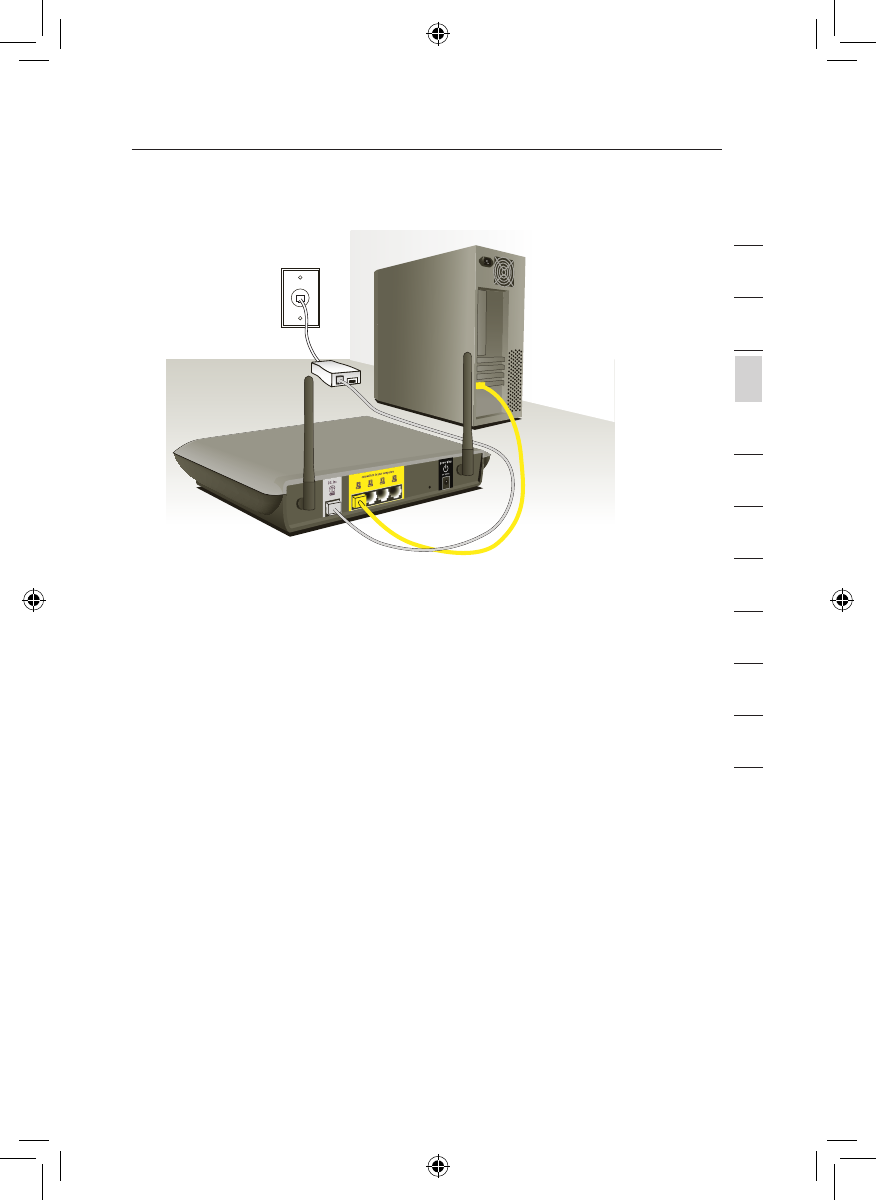
1110
Connecting your Router
11
section
2
1
3
4
5
6
7
8
9
10
11
12
Note: One RJ11 telephone cord is supplied. When inserting an
RJ11 plug, be sure the tab on the plug clicks into position to
ensure that it is properly seated.
3. If you have a dedicated ADSL service telephone line with an RJ11
wall jack, simply connect a telephone cord from the wall jack to
the gray RJ11 port labeled “DSL line” on the back of
your Router.
4. If you have an RJ45 wall jack for your ADSL service, connect an
RJ45-to-RJ11 converter to the wall jack. Then connect one end of
a telephone cord to the converter and the other end to the gray
RJ11 port labeled “DSL line” on the back of your Router.
Note: ADSL microfilter may or may not be provided depending on
your country.
Connecting your Router
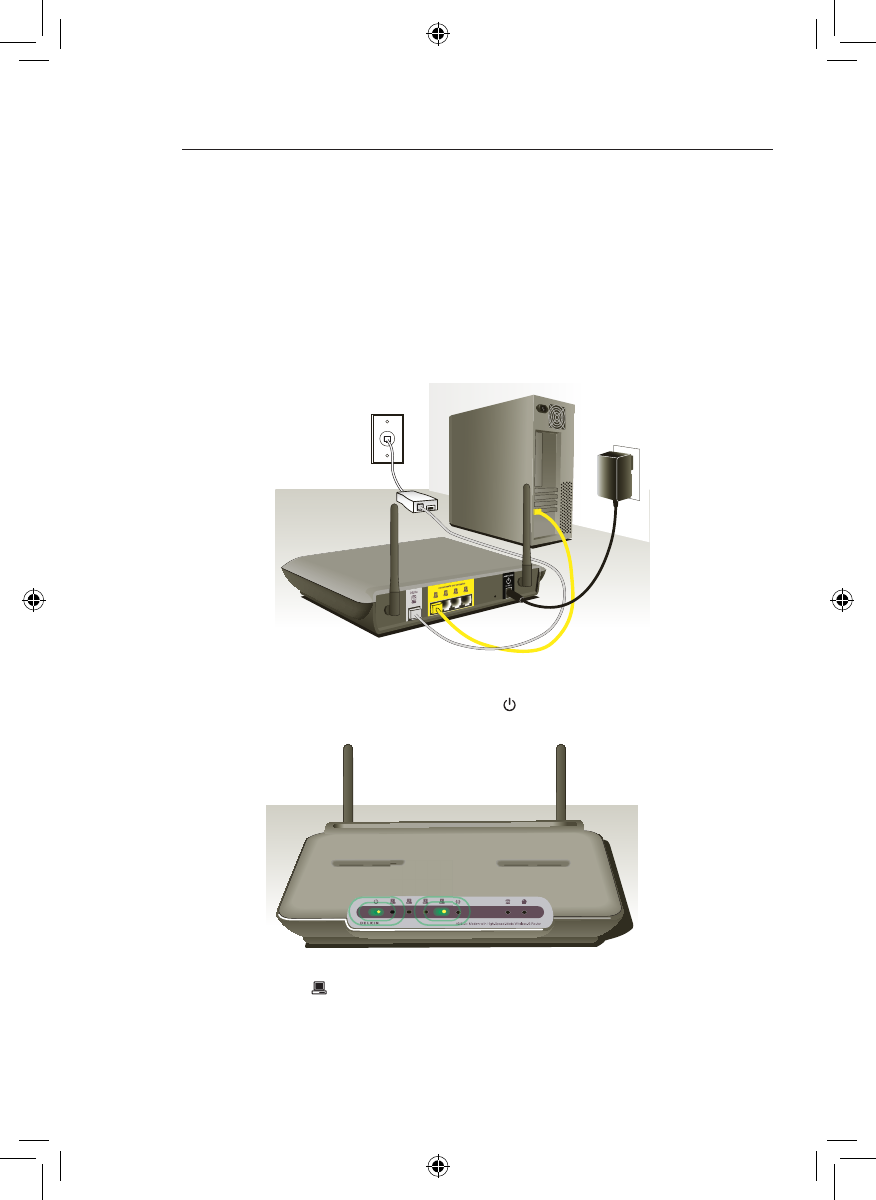
1312
13
Powering Up your Router
1. Connect the supplied power adapter to the Router power-input
plug labeled “Power”.
Note: For safety and performance reasons, only use the supplied
power adapter to prevent damage to the Router.
2. After connecting the power adapter and the power source is
turned on, the Router’s power icon on the front panel should
be on. It might take a few minutes for the Router to fully set up.
3. Turn on your computers. After your computers boot up, the LAN
status LED on the front of the Router will be on for each port
to which a wired computer is connected. These lights show
you the connection and activity status. Now you are ready to
configure the Router for ADSL connection.
Connecting your Router
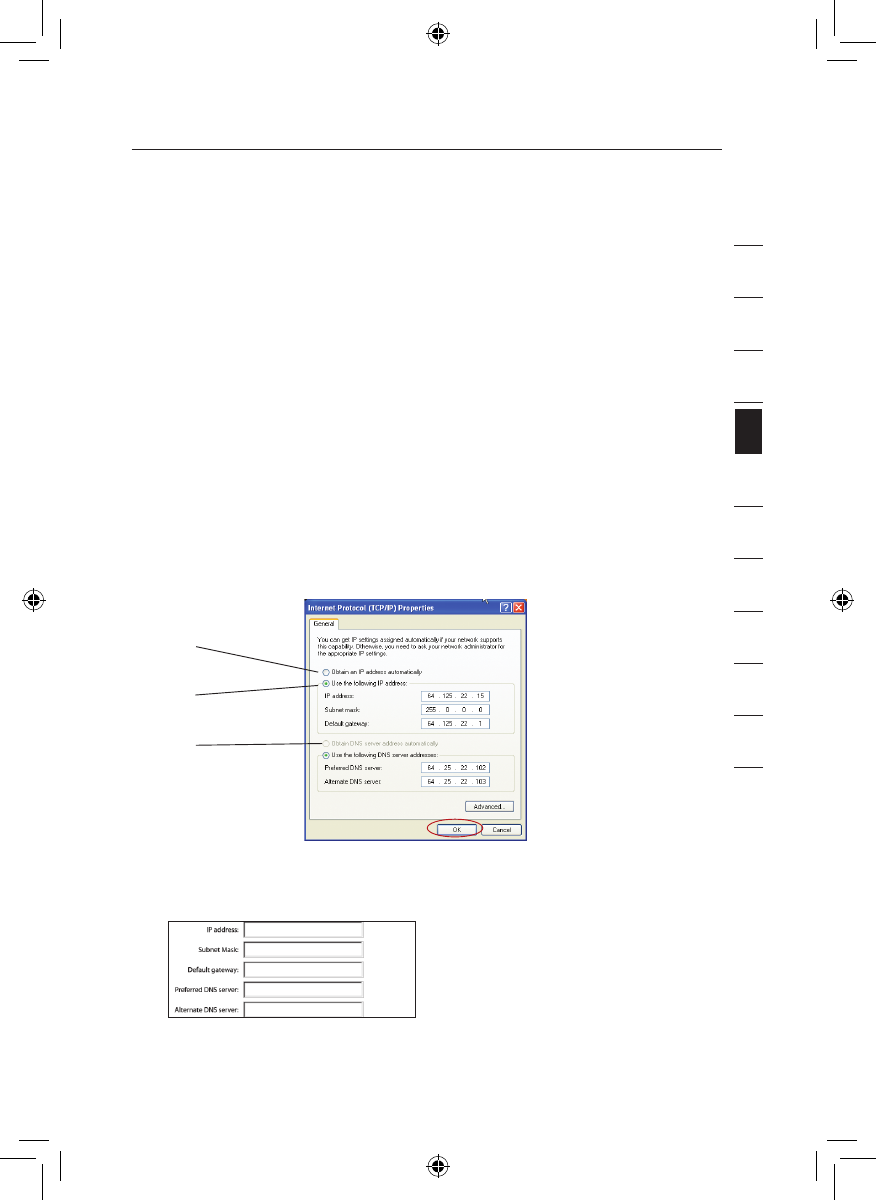
1312
Setting Up your Computers
13
section
2
1
3
4
5
6
7
8
9
10
11
12
In order for your computer to properly communicate with your Router, you
will need to change your computer’s “TCP/IP Ethernet” settings to “Obtain
an IP address automatically/Using DHCP”. This is normally the default
setting in most home computers.
You can set up the computer that is connected to the ADSL modem FIRST
using these steps. You can also use these steps to add computers to your
Router after the Router has been set up to connect to the Internet.
Manually Configuring Network Adapters in Windows XP, 2000, or NT
1. Click “Start”, “Settings”, then “Control Panel”.
2. Double-click on the “Network and dial-up connections” icon
(Windows 2000) or the “Network” icon (Windows XP).
3. Right-click on the “Local Area Connection” associated with your
network adapter and select “Properties” from the drop-down menu.
4. In the “Local Area Connection Properties” window, click “Internet
Protocol (TCP/IP)” and click the “Properties” button. The following
screen will appear:
5. If “Use the following IP address” (2) is selected, your Router will need to
be set up for a static IP connection type. Write the address information
the table below. You will need to enter this information into the Router.
6. If not already selected, select “Obtain an IP address automatically”
(1) and “Obtain DNS server address automatically” (3). Click “OK”.
Your network adapter(s) are now configured for use with the Router.
(1)
(2)
(3)
Connecting your Router
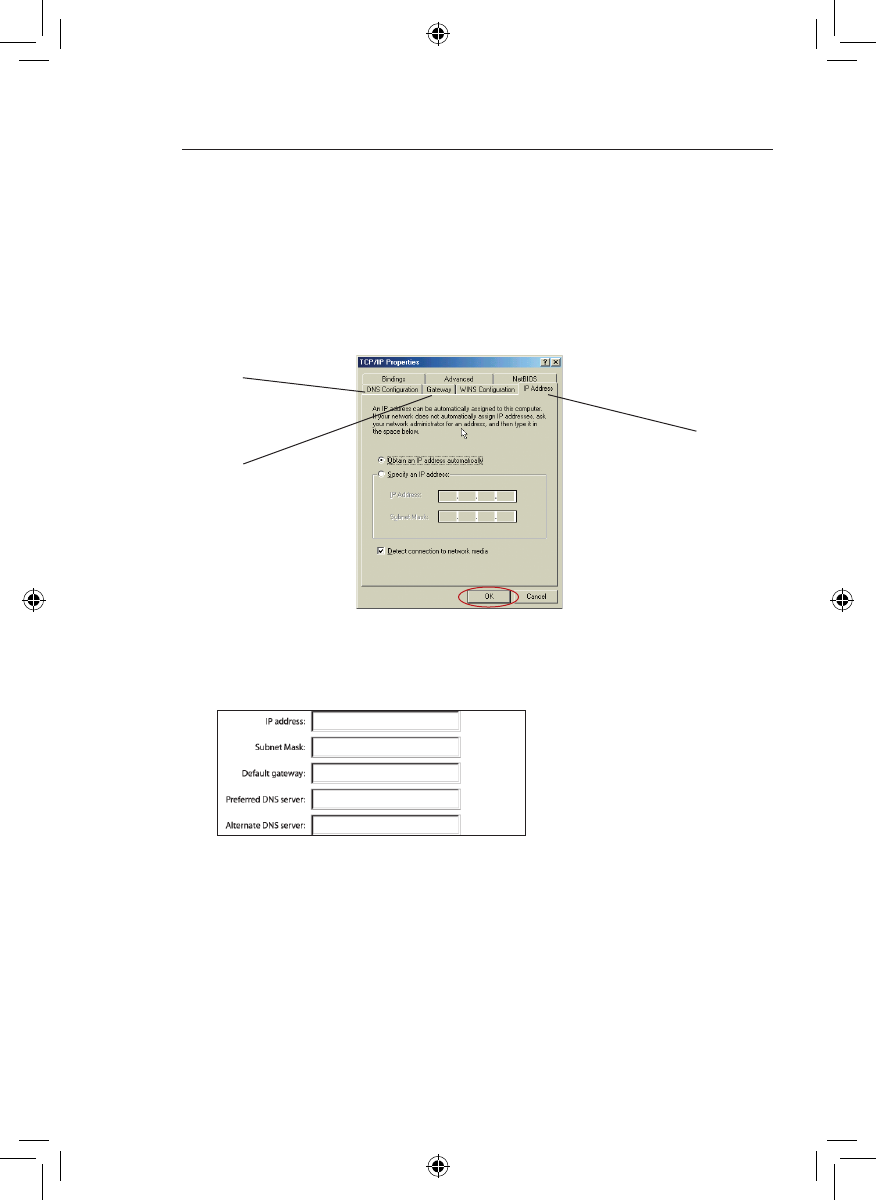
1514
Setting Up your Computers
15
Manually Configuring Network Adapters in Windows 98SE or Me
1. Right-click on “My Network Neighborhood” and select
“Properties” from the drop-down menu.
2. Select “TCP/IP -> settings” for your installed network adapter.
You will see the following window.
3. If “Specify an IP address” is selected, your Router will need
to be set up for a static IP connection type. Write the address
information in the table below. You will need to enter this
information into the Router.
(1)
(2)
(3)
4. Write the IP address and subnet mask from the “IP Address”
tab (3).
5. Click the “Gateway” tab (2). Write the gateway address down in
the chart.
6. Click the “DNS Configuration” tab (1). Write the DNS address(es)
in the chart.
7. If not already selected, select “Obtain an IP address
automatically” on the IP address tab. Click “OK”.
Restart the computer. When the computer restarts, your network
adapter(s) are now configured for use with the Router.
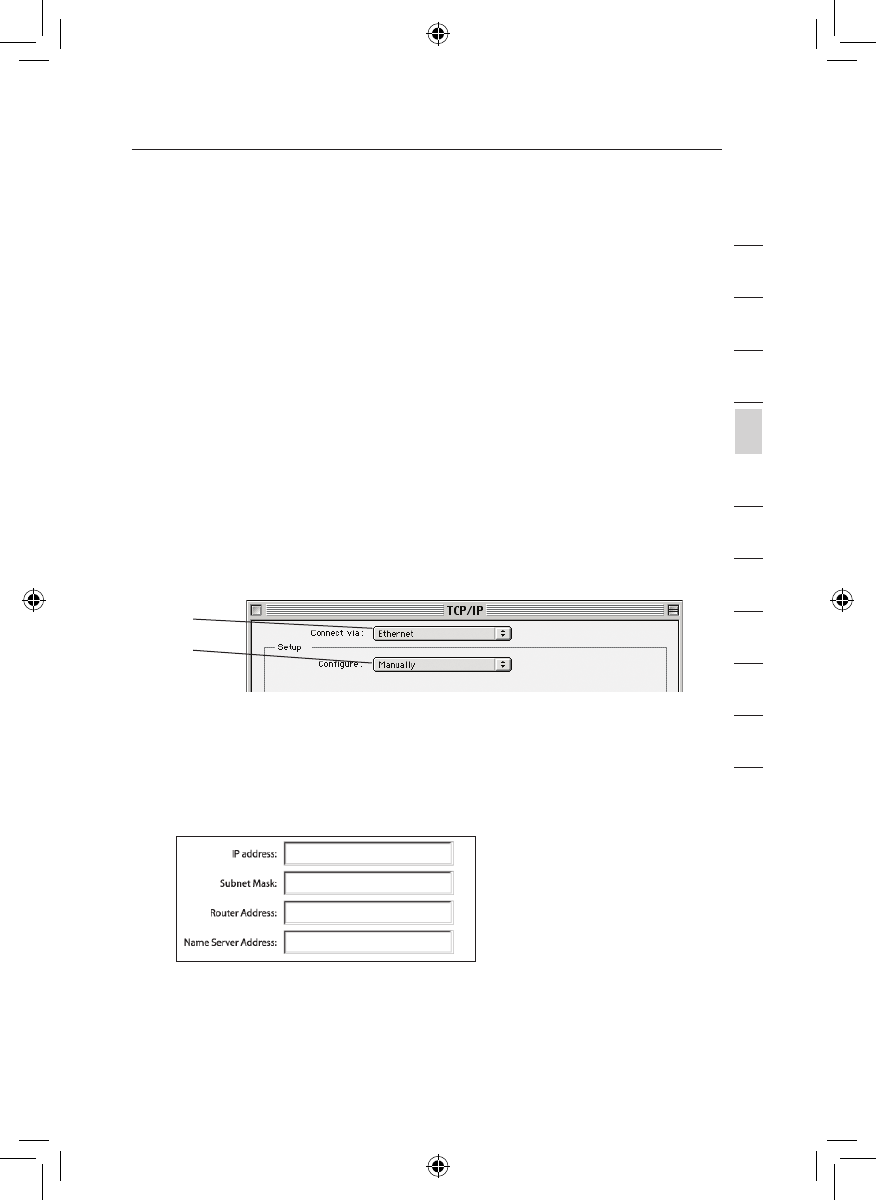
1514
Setting Up your Computers
Setting Up your Computers
15
section
2
1
3
4
5
6
7
8
9
10
11
12
Set up the computer that is connected to the cable or DSL modem
by FIRST using these steps. You can also use these steps to add
computers to your Router after the Router has been set up to connect
to the Internet.
Manually Configuring Network Adapters in Mac OS
up to 9.x
In order for your computer to properly communicate with your Router,
you will need to change your Mac computer’s TCP/IP settings to DHCP.
1. Pull down the Apple menu. Select “Control Panels” and
select “TCP/IP”.
2. You will see the TCP/IP control panel. Select “Ethernet Built-In”
or “Ethernet” in the “Connect via:” drop-down menu (1).
3. Next to “Configure” (2), if “Manually” is selected, your Router
will need to be set up for a static IP connection type. Write the
address information in the table below. You will need to enter this
information into the Router.
(1)
(2)
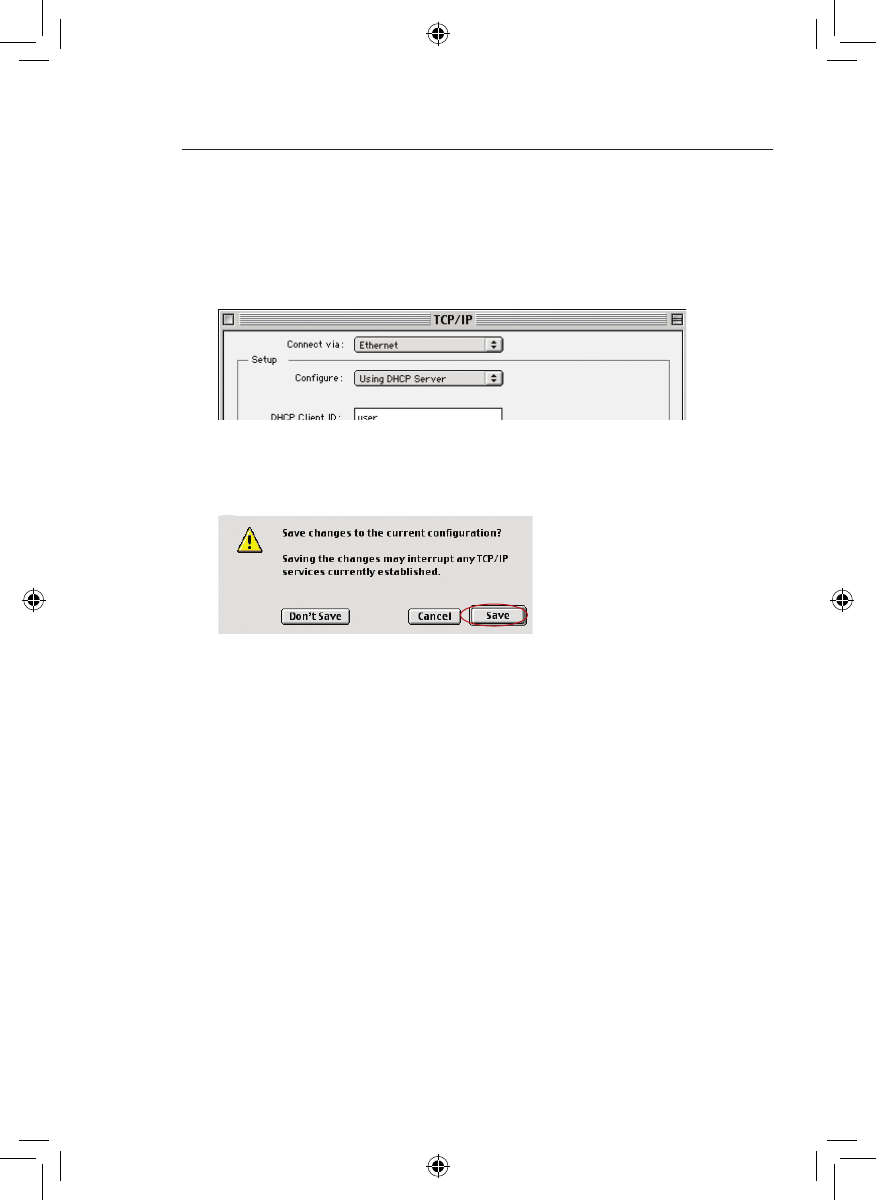
1716
Setting Up your Computers
17
5. Close the window. If you made any changes, the following
window will appear. Click “Save”.
Restart the computer. When the computer restarts, your network
settings are now configured for use with the Router.
4. If not already set, at “Configure:”, choose “Using DHCP
Server”. This will tell the computer to obtain an IP address
from the Router.
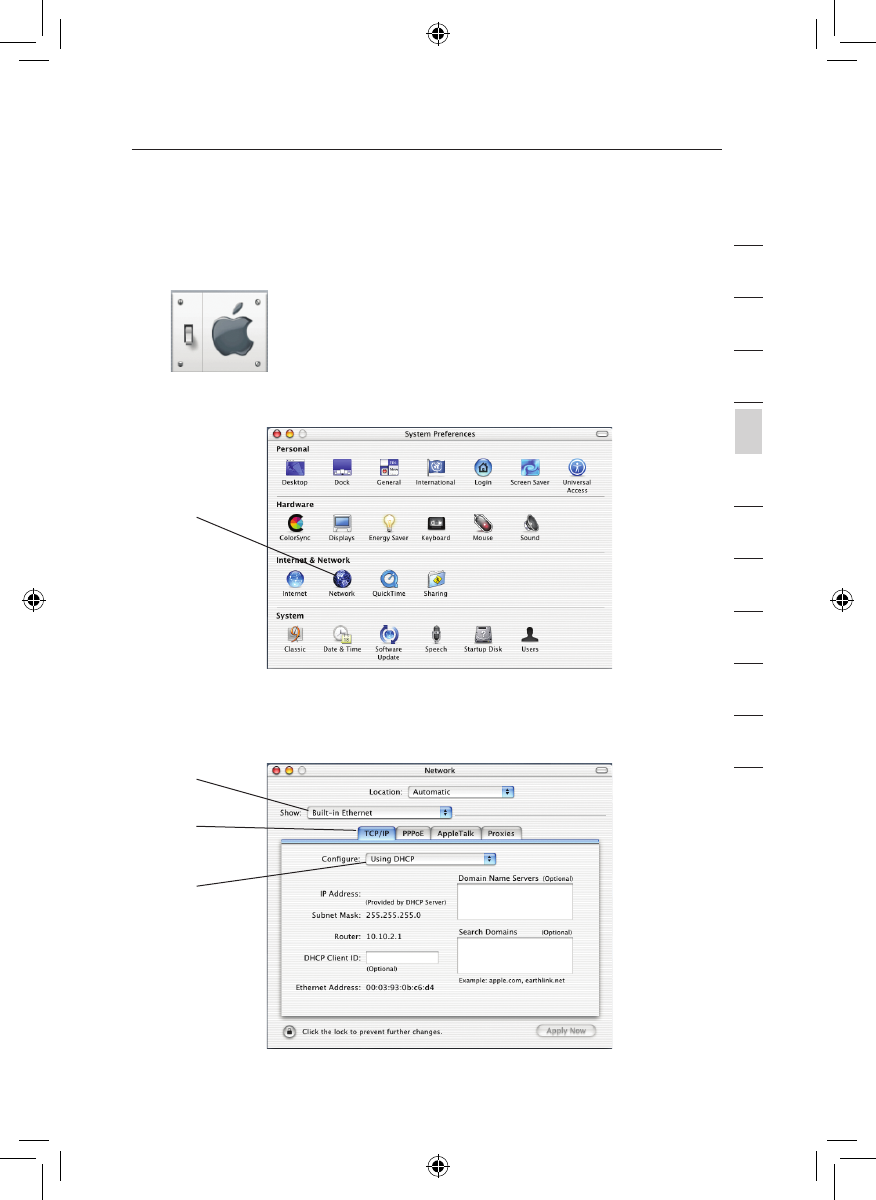
1716
Setting Up your Computers
Setting Up your Computers
17
section
2
1
3
4
5
6
7
8
9
10
11
12
Manually Configuring Network Adapters in Mac OS X
1. Click on the “System Preferences” icon.
2. Select “Network” (1) from the “System Preferences” menu.
3. Select “Built-in Ethernet” (2) next to “Show” in the
Network menu.
(1)
(2)
(3)
(4)

1918
Setting Up your Computers
19
4. Select the “TCP/IP” tab (3). Next to “Configure” (4), you should
see “Manually” or “Using DHCP”. If you do not, check the
PPPoE tab (5) to make sure that “Connect using PPPoE” is NOT
selected. If it is, you will need to configure your Router for a
PPPoE connection type using your user name and password.
5. If “Manually” is selected, your Router will need to be set up
for a static IP connection type. Write the address information
in the table below. You will need to enter this information into
the Router.
6. If not already selected, select “Using DHCP” next to “Configure”
(4), then click “Apply Now”.
Your network adapter(s) are now configured for use with the Router.
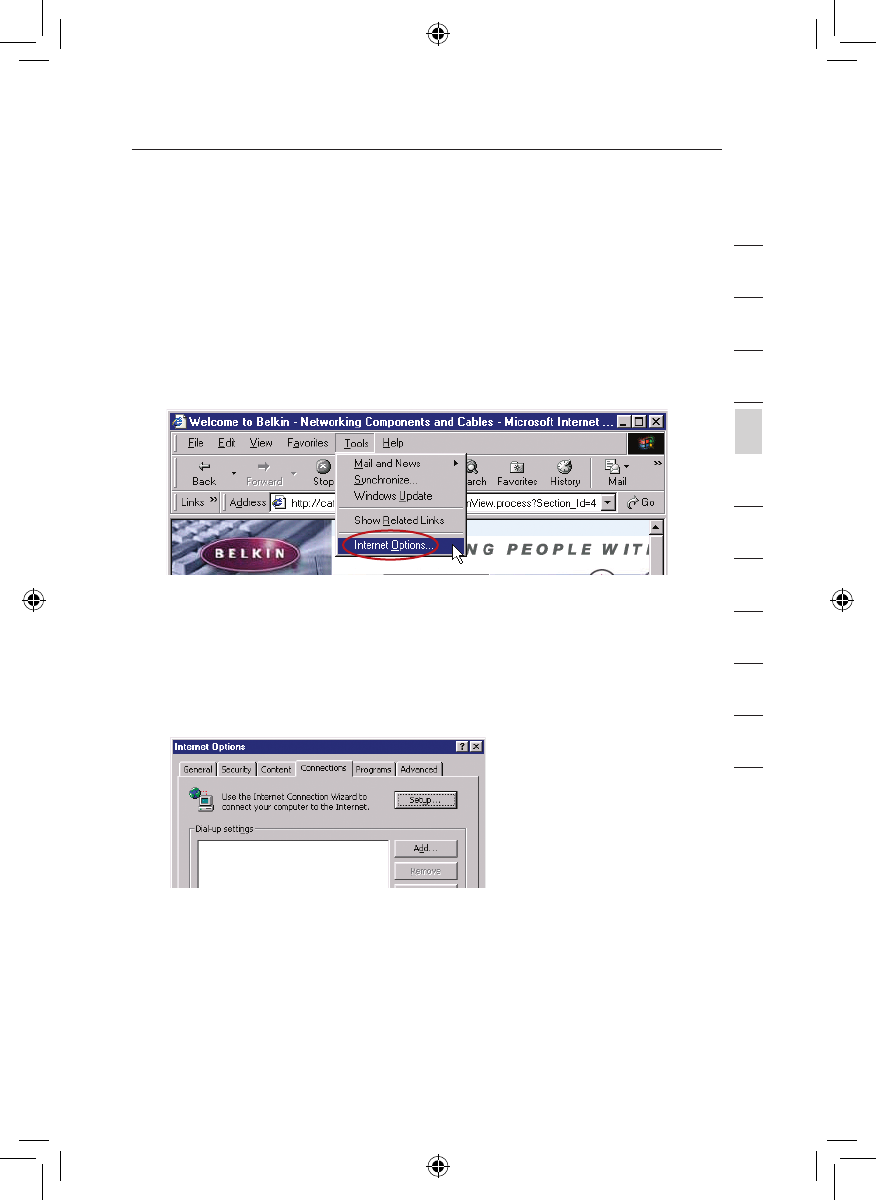
1918
Setting Up your Computers
Setting Up your Computers
19
section
2
1
3
4
5
6
7
8
9
10
11
12
Recommended Web Browser Settings
In most cases, you will not need to make any changes to your web
browser’s settings. If you are having trouble accessing the Internet or
the advanced web-based user interface, then change your browser’s
settings to the recommended settings in this section.
Internet Explorer 4.0 or Higher
1. Start your web browser. Select “Tools” then “Internet Options”.
2. In the “Internet Options” screen, there are three selections:
“Never dial a connection”, “Dial whenever a network connection
is not present”, and “Always dial my default connection”. If you
can make a selection, select “Never dial a connection”. If you
cannot make a selection, go to the next step.
3. Under the “Internet Options” screen, click on “Connections” and
select “LAN Settings…”.
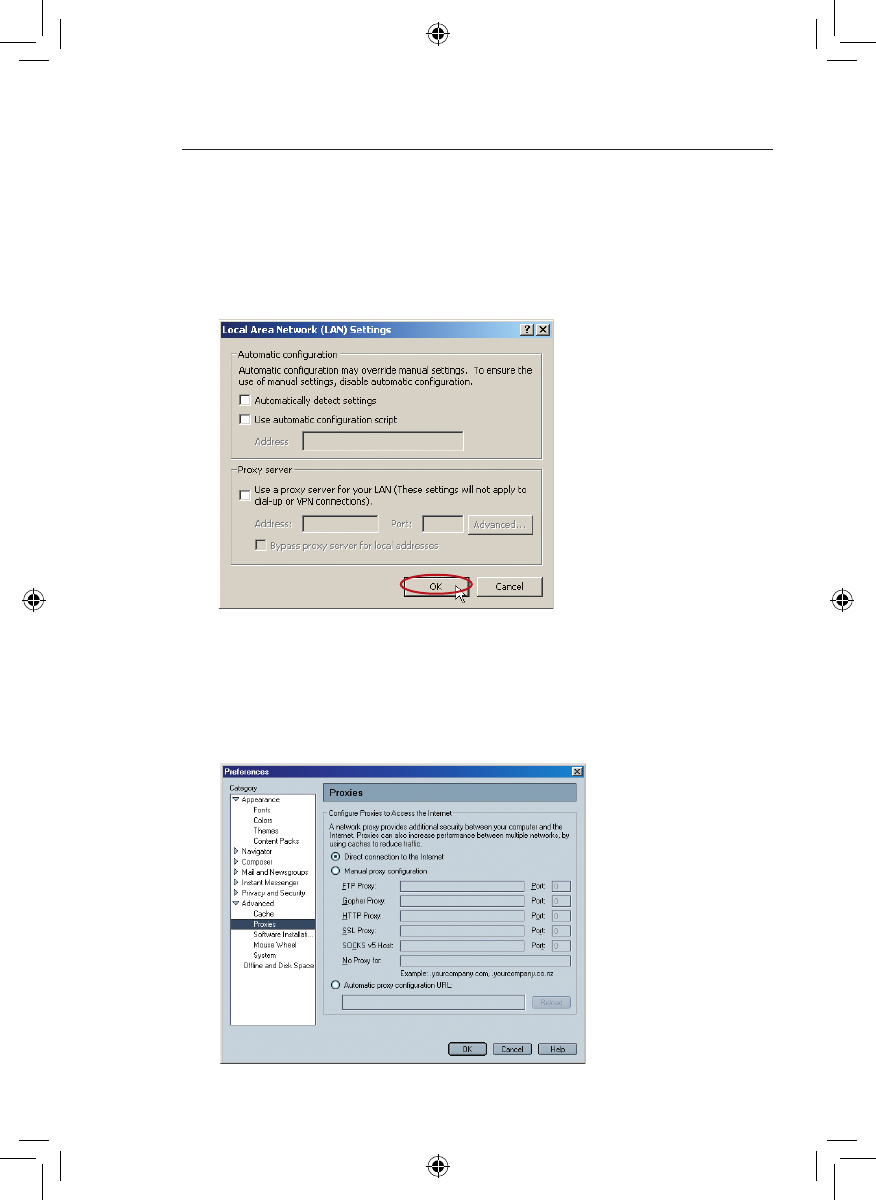
2120
21
4. Make sure there are no check marks next to any of the displayed
options: “Automatically detect settings”, “Use automatic
configuration script”, and “Use a proxy server”. Click “OK”. Then
click “OK” again in the “Internet Options” page.
Netscape Navigator 4.0 or Higher
1. Start Netscape. Click on “Edit” then “Preferences”.
2. In the “Preferences” window, click on “Advanced” then select
“Proxies”. In the “Proxies” window, select “Direct connection to
the Internet”.
Setting Up your Computers
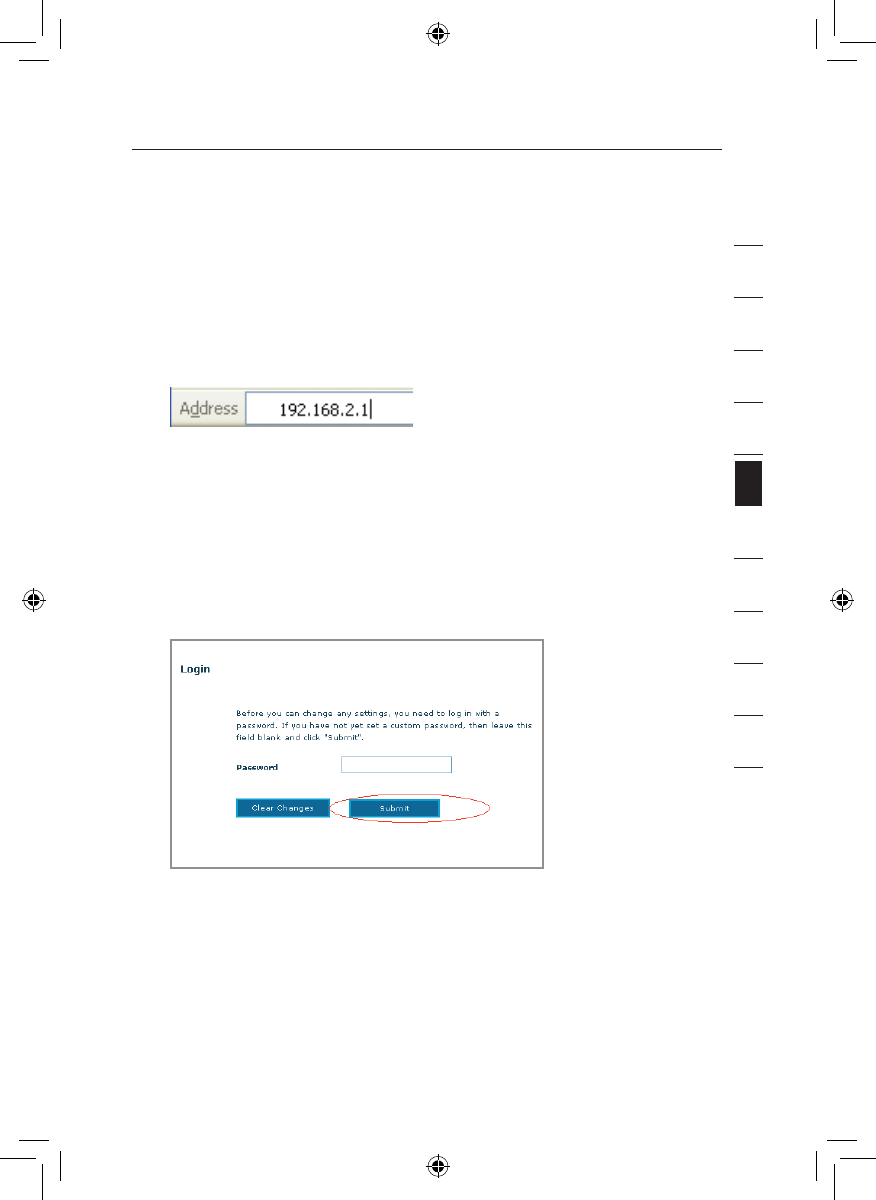
2120
Configuring your Router with the Setup Wizard
21
section
2
1
3
4
5
6
7
8
9
10
11
12
Running the Setup Wizard
1. You can access the web-based management user interface of the
Router using the Internet browser on a computer connected to
the Router. Type “192.168.2.1” (do not type in anything else such
as “http://” or “www”) in your browser’s address bar. Then press
the “Enter” key.
Note: It is strongly recommended that you use a computer
physically connected to the Router with an RJ45 cable for initial
setup. Using a wirelessly connected computer for initial setup is
not recommended.
2. The following screen will appear in your browser to prompt you
to log in. The default User Name is “Admin” and the default
Password is “Admin”. Enter both User Name and Password, then
click the “Submit” button to log in.
Note: It is strongly recommended that you change the password
to your own for increased security. Please read the following
section, entitled “Manually Configuring your Router”, for details
on how to change your password and to reference other
security features.
Setting Up your Computers
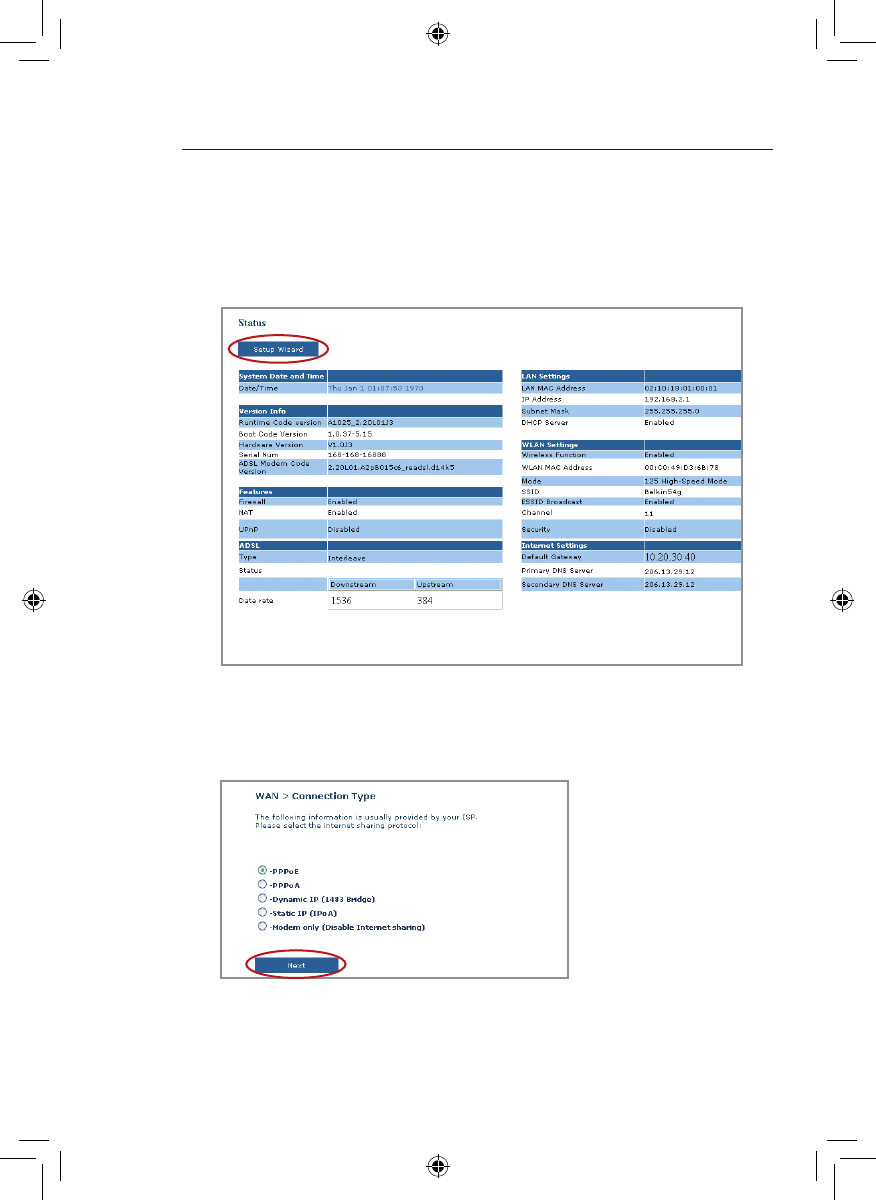
2322
Configuring your Router with the Setup Wizard
23
3. A Status page will follow showing detail status of your Router.
Next, click on the “Setup Wizard” button for express
configuration (recommended).
4. Click on the “Setup Wizard” button to start the Router’s Setup
Wizard. The first step is to select your connection type (this
information is provided by your ISP) and click “Next”.
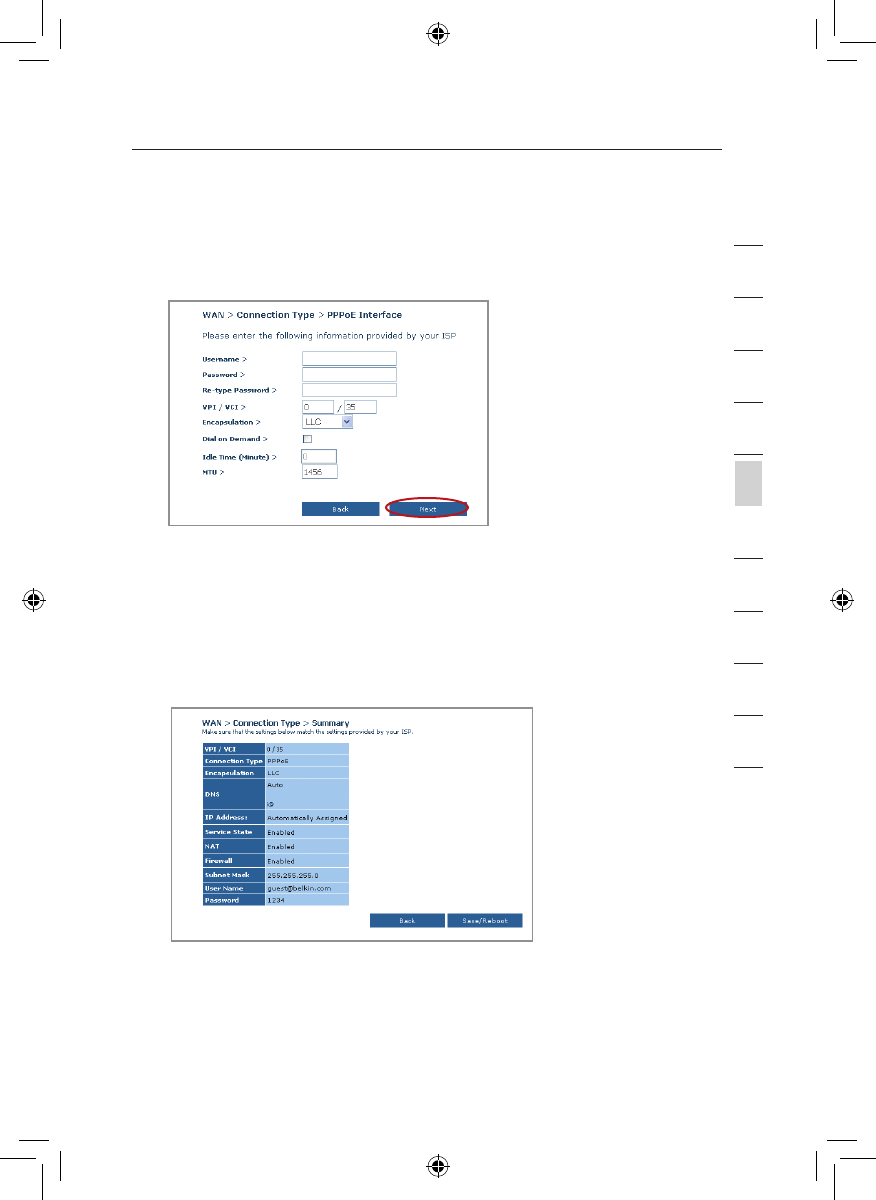
2322
Configuring your Router with the Setup Wizard
Configuring your Router with the Setup Wizard
23
section
2
1
3
4
5
6
7
8
9
10
11
12
5. Now enter the required values provided by your ISP. For the
“PPPoE” or “PPPoA” page you will see the following screen.
Enter the required values provided by your ISP and click “Next”.
Note: For more detailed instruction on other connection types,
please refer to the “Manually Configuring your Router” section of
this User Manual.
6. Double-check the settings shown on the following screen. You
can click “Back” to change the settings or click “Apply” to
activate your settings.
Note: You can always restart the Setup Wizard or use the
Navigation Menu on the left to change your setting.

2524
25
Connecting to the Wireless LAN
7. Now you can connect to the Router via a wireless-LAN-enabled
computer with the following default wireless LAN settings:
Wireless Channel = 11
SSID = belkin54g
Security = off
Note: Belkin strongly recommends that you enable wireless
security to WEP or WPA and change SSID to something of
your own. Please read the User Manual for details on levels of
wireless security and how to change your security settings.
8. Congratulations! You have finished installing your new Belkin
Router. To test your Internet connection, open your browser
and visit any website, such as www.belkin.com. For advanced
features and more detailed installation and security setup
information, see the following section, “Manually Configuring
your Router”.
Configuring Your Router with the Setup Wizard
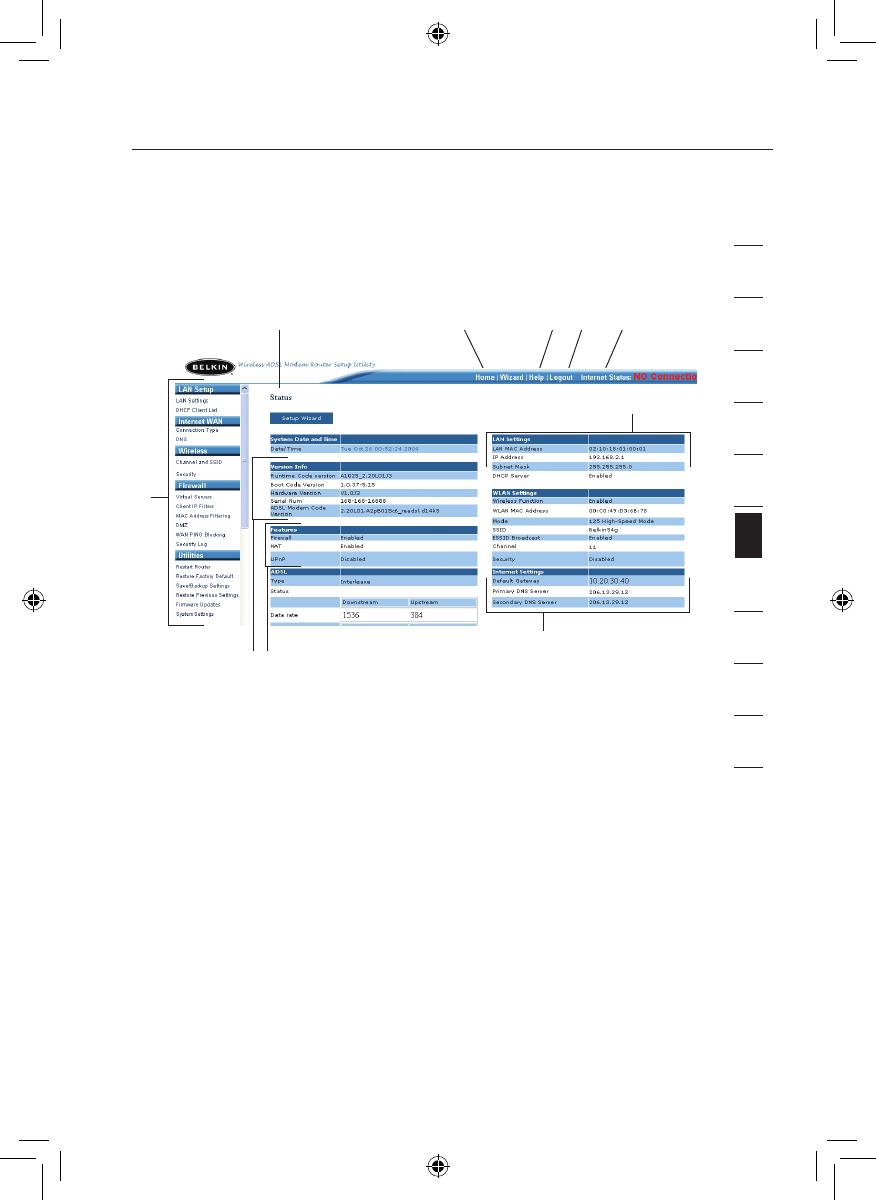
2524
Manually Configuring your Router
25
section
2
1
3
4
5
6
7
8
9
10
11
12
Configuring Your Router with the Setup Wizard
Understanding the Web-Based User Interface
The home page shows you a quick view of the Router’s status and
settings. All advanced setup pages can be reached from this page.
1. Quick-Navigation Links
You can go directly to any of the Router’s UI pages by clicking
directly on these links. The links are divided into logical
categories and grouped by tabs to make finding a particular
setting easier to find. Clicking on the header of each tab will
show you a short description of the tab’s function.
2. Home Button
The “Home” button is available in every page of the UI. Pressing
this button will take you back to the home page.
3. Help Button
The “Help” button gives you access to the Router’s help pages.
Help is also available on many pages by clicking “more info” next
to certain sections of each page.
4. Login/Logout Button
This button enables you to log in and out of the Router with the
press of one button. When you are logged into the Router, this
button will change to read “Logout”. Logging into the Router will
(1)
(9)
(2) (5)(4)(3)
(10)
(6)
(8)
(7)

2726
Manually Configuring your Router
27
Manually Configuring your Router
take you to a separate login page where you will need to enter a
password. When you are logged into the Router, you can make
changes to the settings. When you are finished making changes,
you can log out of the Router by clicking the “Logout” button.
For more information about logging into the Router, see the
section called “Logging into the Router”.
5. Internet Status Indicator
This indicator is visible in all pages of the Router, showing
the connection status of the Router. When the indicator says
“connection OK” in GREEN, the Router is connected to the
Internet. When the Router is not connected to the Internet, the
indicator will read “no connection” in RED. The indicator is
automatically updated when you make changes to the settings of
the Router.
6. LAN Settings
Shows you the settings of the Local Area Network (LAN) side of
the Router. Changes can be made to the settings by clicking the
“LAN” “Quick Navigation” link on the left side of the screen.
7. Features
Shows the status of the Router’s UPnP, NAT, and firewall
features. Changes can be made to the settings by clicking on any
one of the links or by clicking the “Quick Navigation” links on the
left side of the screen.
8. Internet Settings
Shows the settings of the Internet/WAN side of the Router that
connects to the Internet. Changes to any of these settings can be
made by clicking on the “Internet/WAN” “Quick Navigation” link
on the left side of the screen.
9. Version Info
Shows the firmware version, boot-code version, hardware
version, and serial number of the Router.
10. Page Name
The page you are on can be identified by this name. This manual
will sometimes refer to pages by name. For instance, “LAN > LAN
Settings” refers to the “LAN Settings” page.
Configuring Your Router with the Setup Wizard
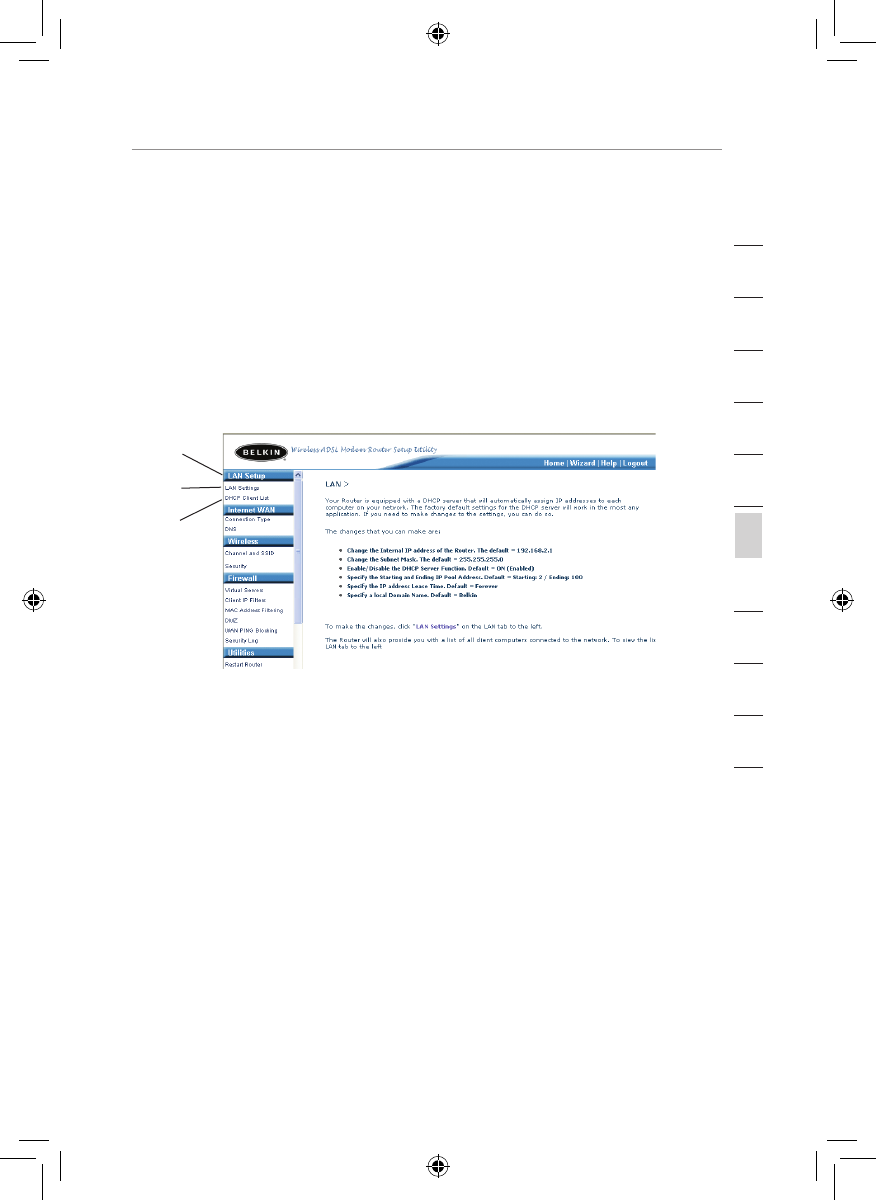
2726
Manually Configuring your Router
Manually Configuring your Router
27
Manually Configuring your Router
section
2
1
3
4
5
6
7
8
9
10
11
12
Changing LAN Settings
All settings for the internal LAN setup of the Router can be viewed
and changed here.
Clicking on the header of the LAN tab (1) will take you to the LAN
tab’s header page. A quick description of the functions can be
found here. To view the settings or make changes to any of the LAN
settings, click on “LAN Settings” (2) or to view the list of connected
computers, click on “DHCP Client List” (3).
(1)
(2)
(3)
Configuring Your Router with the Setup Wizard
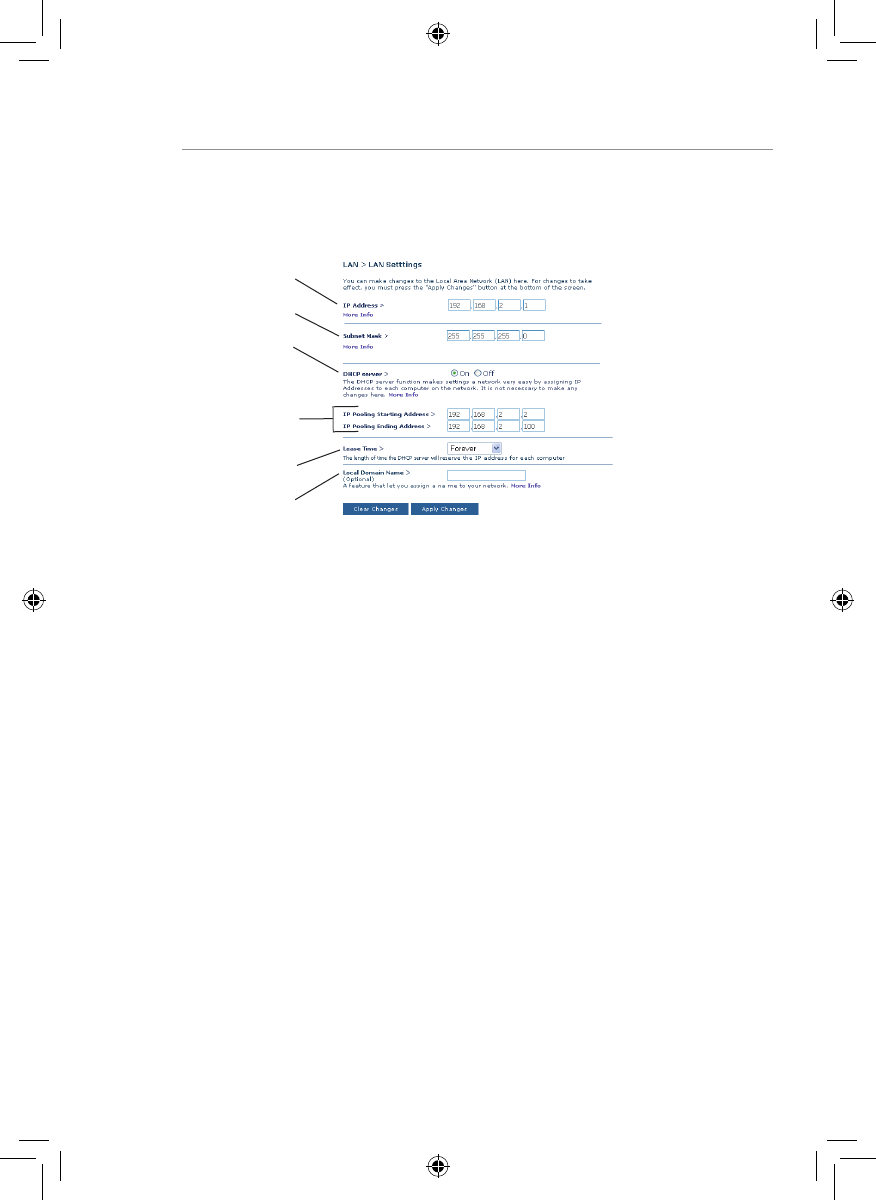
2928
Manually Configuring your Router
29
Manually Configuring your Router
(1)
(2)
(3)
(4)
(5)
(6)
1. IP Address
The “IP address” is the internal IP address of the Router.
The default IP address is “192.168.2.1”. To access the setup
interface, type this IP address into the address bar of your
browser. This address can be changed if needed. To change
the IP address, type in the new IP address and click “Apply
Changes”. The IP address you choose should be a non-routable
IP. Examples of a non-routable IP are:
192.168.x.x (where x is anything between 0 and 255)
10.x.x.x (where x is anything between 0 and 255)
2. Subnet Mask
There is no need to change the subnet mask. This is a unique,
advanced feature of your Belkin Router.
3. DHCP Server
The DHCP server function makes setting up a network very easy
by assigning IP addresses to each computer on the network
automatically. The default setting is “On”. The DHCP server can
be turned OFF if necessary, however, in order to do so you must
manually set a static IP address for each computer on your network.
To turn off the DHCP server, select “Off” and click “Apply Changes”.
4. IP Pool
The IP Pool is the range of IP addresses set aside for dynamic
assignment to the computers on your network. The default is
LAN Settings

2928
Manually Configuring your Router
Manually Configuring your Router
29
Manually Configuring your Router
section
2
1
3
4
5
6
7
8
9
10
11
12
2–100 (99 computers). If you want to change this number, you
can do so by entering a new starting and ending IP address and
clicking on “Apply Changes”. The DHCP server can assign 100 IP
addresses automatically. This means that you cannot specify an
IP address pool larger than 100 computers. For example, starting
at 50 means you have to end at 150 or lower so as not to exceed
the 100-client limit. The starting IP address must be lower in
number than the ending IP address.
5. Lease Time
Lease time is the length of time the DHCP server will reserve
the IP address for each computer. We recommend that you
leave the lease time set to “Forever”. The default setting is
“Forever”, meaning that any time a computer is assigned an
IP address by the DHCP server, the IP address will not change
for that particular computer. Setting lease times for shorter
intervals, such as one day or one hour, frees IP addresses after
the specified period of time. This also means that a particular
computer’s IP address may change over time. If you have set any
of the other advanced features of the Router, such as DMZ or
client IP filters, these are dependent on the IP address. For this
reason, you will not want the IP address to change.
6. Local Domain Name
The default setting is “Belkin”. You can set a local domain name
(network name) for your network. There is no need to change this
setting unless you have a specific advanced need to do so. You can
name the network anything you want such as “MY NETWORK”.
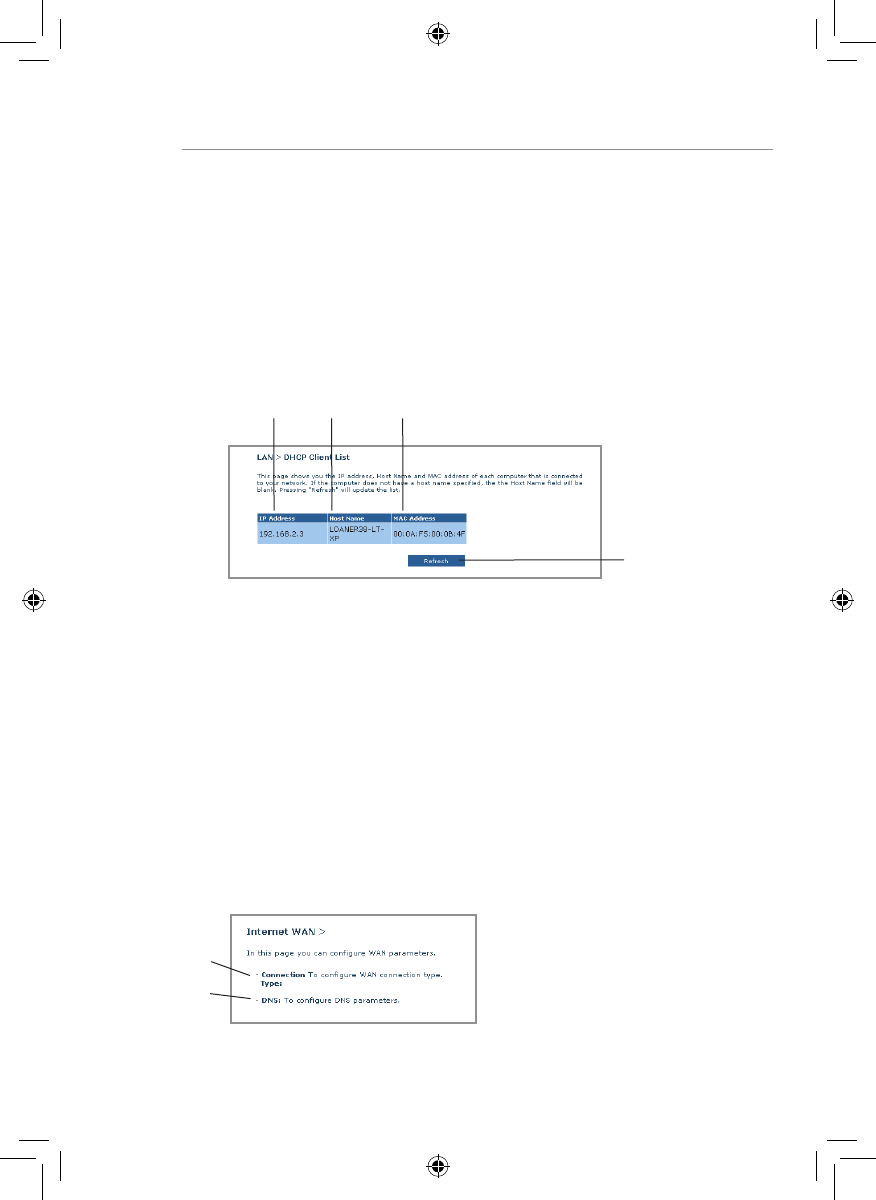
3130
Manually Configuring your Router
31
Manually Configuring your Router
DHCP Client List
You can view a list of the computers (known as clients), which are
connected to your network. You are able to view the IP address (1) of
the computer, the host name (2) (if the computer has been assigned
one), and the MAC address (3) of the computer’s Network Interface
Card (NIC). Pressing the “Refresh” (4) button will update the list. If
there have been any changes, the list will be updated.
Internet WAN
The “Internet WAN” tab is where you will set up your Router to connect
to your Internet Service Provider. The Router is capable of connecting
to virtually any ADSL Service Provider’s system provided you have
correctly configured the Router’s settings for your ISP’s connection type.
Your connection settings are provided to you by your ISP. To configure
the Router with the settings that your ISP gave you, click “Connection
Type” (1) on the left side of the screen. Select the connection type you
use. If your ISP gave you DNS settings, clicking “DNS” (2) allows you to
enter DNS address entries for ISPs that require specific settings.
When you have finished making settings, the “Internet Status” indicator
will read “Connection OK” if your Router is set up properly.
(1) (2) (3)
(4)
(1)
(2)
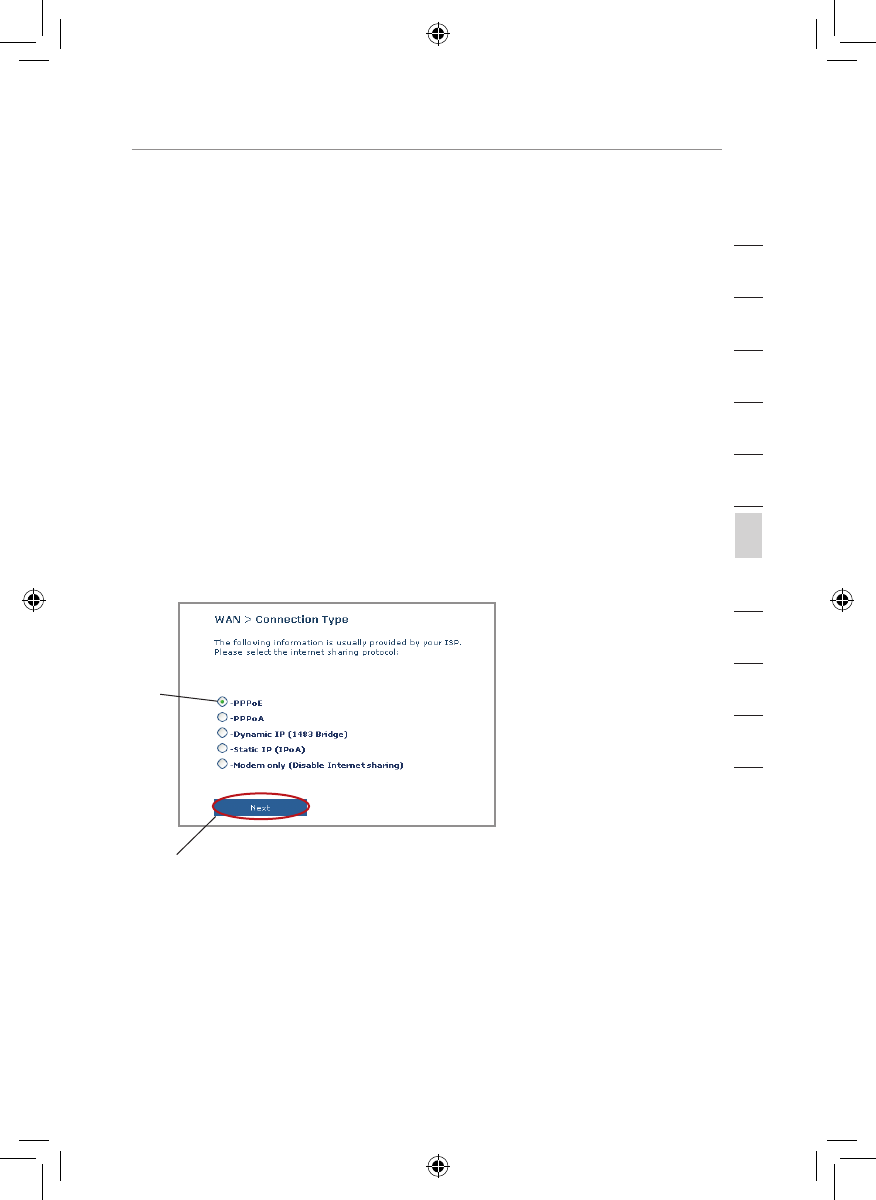
3130
Manually Configuring your Router
Manually Configuring your Router
31
Manually Configuring your Router
section
2
1
3
4
5
6
7
8
9
10
11
12
Connection Type
From the “Connection Type” page, you can select one of these five
connection types based on the instruction provided by your ISP:
• PPPoE
• PPPoA
• Dynamic IP (1483 Bridged)
• Static IP (IPOA)
• Modem Only (Disable Internet Sharing)
Note: See Appendix C in this User Manual for some common DSL
Internet setting parameters. If you are not sure, please contact your ISP.
Select the type of connection you use by clicking the radio button (1)
next to your connection type and then clicking “Next” (2).
(2)
(1)
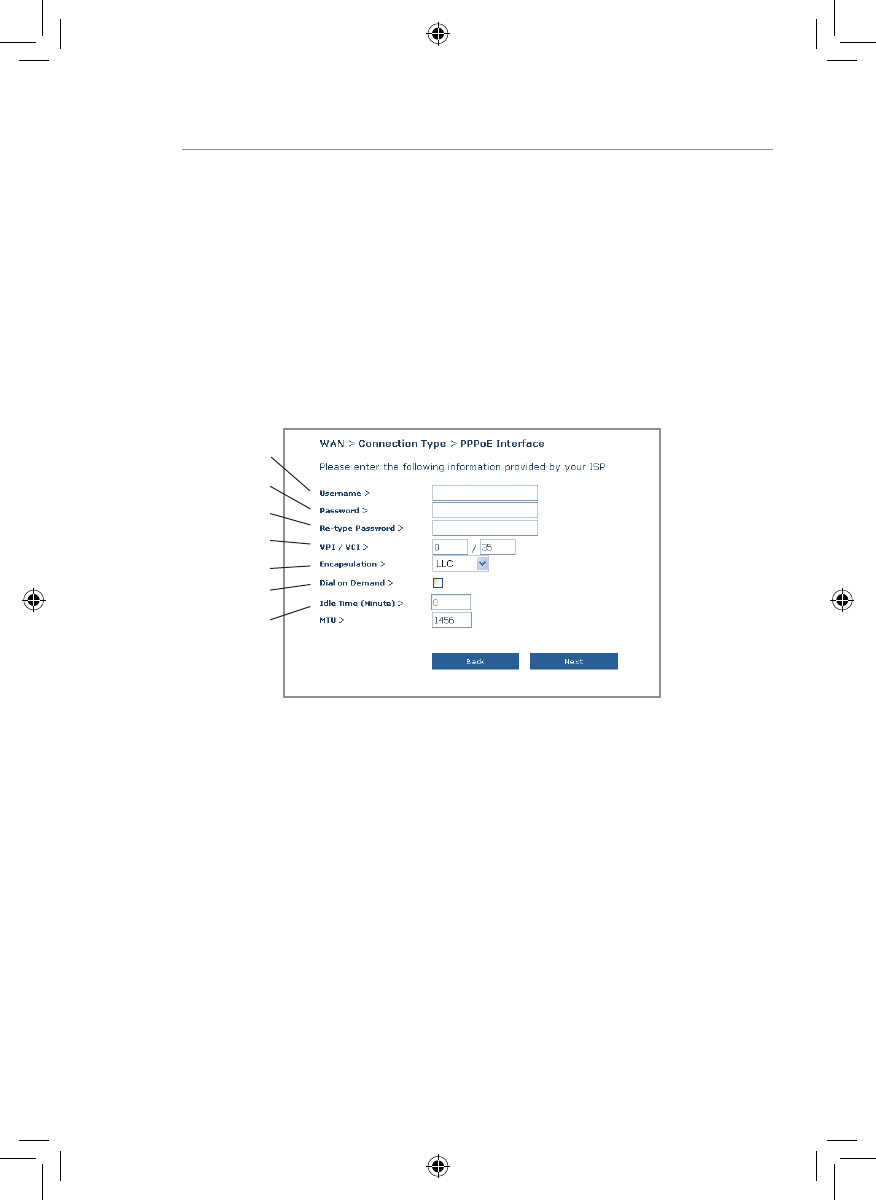
3332
Manually Configuring your Router
33
Manually Configuring your Router
Setting your ISP Connection Type to PPPoE or PPPoA
PPPoE (Point-to-Point Protocol over Ethernet) is the standard
method of connecting networked devices. It requires a user name and
password to access the network of your ISP for connecting to the
Internet. PPPoA (PPP over ATM) is similar to PPPoE, but is mostly
implemented in the UK. Select PPPoE or PPPoA and click “Next”.
Then enter the information provided by your ISP, and click “Apply
Changes” to activate your settings.
1. User Name - Enter the user name. (Assigned by your ISP).
2. Password - Enter your password. (Assigned by your ISP).
3. Retype Password - Confirm the password. (Assigned by your ISP).
4. VPI/VCI - Enter your Virtual Path Identifier (VPI) and Virtual Circuit
Identifier (VCI) parameter here. (Assigned by your ISP).
5. Encapsulation - Select your encapsulation type (supplied by your ISP)
to specify how to handle multiple protocols at the ATM transport layer.
VC-MUX: PPPoA Virtual Circuit Multiplexer (null encapsulation) allows
only one protocol running per virtual circuit with fewer overheads.
LLC: PPPoA Logical Link Control allows multiple protocols running over
one virtual circuit (more overhead).
6. Dial on Demand - By selecting “Dial on Demand” your Router will
automatically connect to the Internet when a user opens up a web browser.
7. Idle Time (Minutes) - Enter the maximum idle time for the Internet
connection. After this time has been exceeded, the connection will
be terminated.
(1)
(2)
(3)
(4)
(5)
(6)
(7)
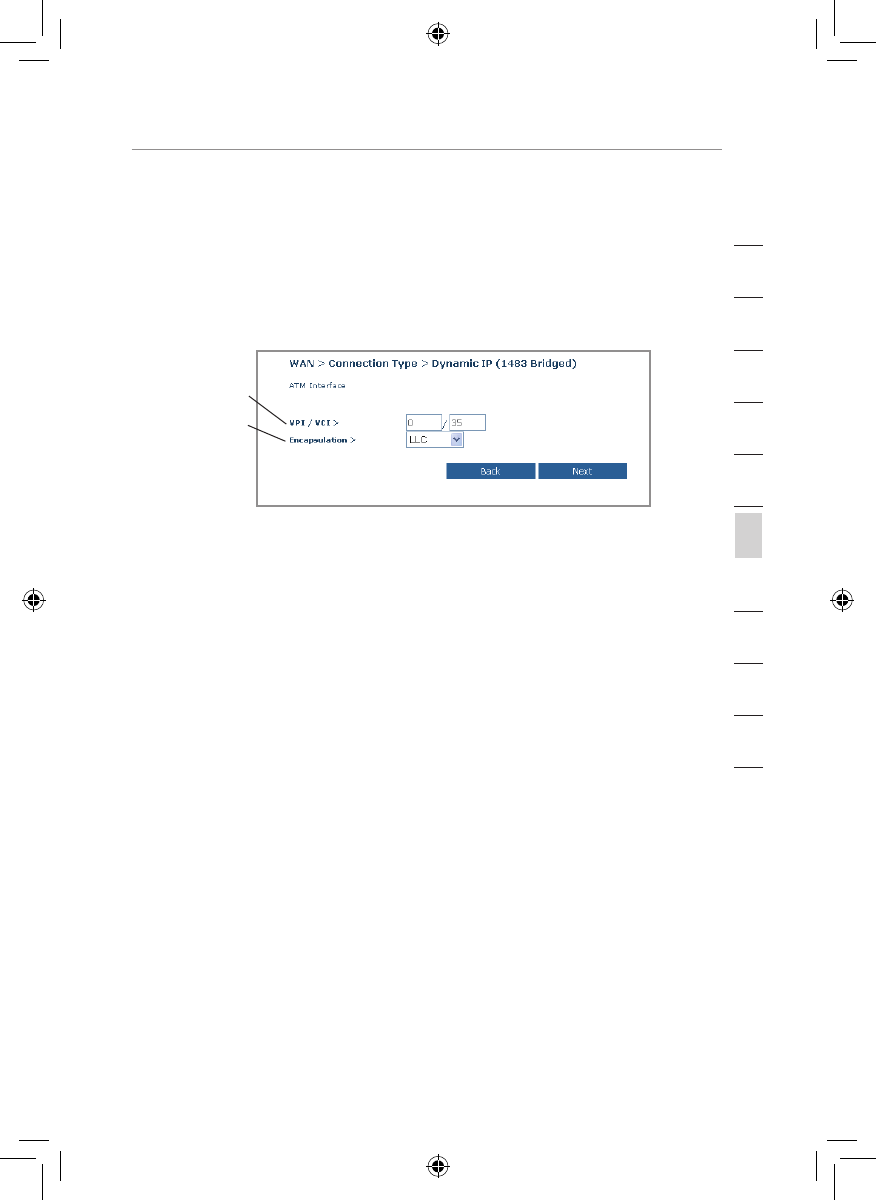
3332
Manually Configuring your Router
Manually Configuring your Router
33
Manually Configuring your Router
section
2
1
3
4
5
6
7
8
9
10
11
12
Setting your Connection Type to Dynamic IP (1483 Bridged)
This connection method bridges your network and ISP’s network
together. The Router will obtain an IP address automatically from your
ISP’s DHCP server.
1. VPI/VCI - Enter your Virtual Path Identifier (VPI) and Virtual Circuit
Identifier (VCI) parameter here. These identifiers are assigned by your ISP.
2. Encapsulation - Select LLC or VC MUX your ISP uses.
(1)
(2)
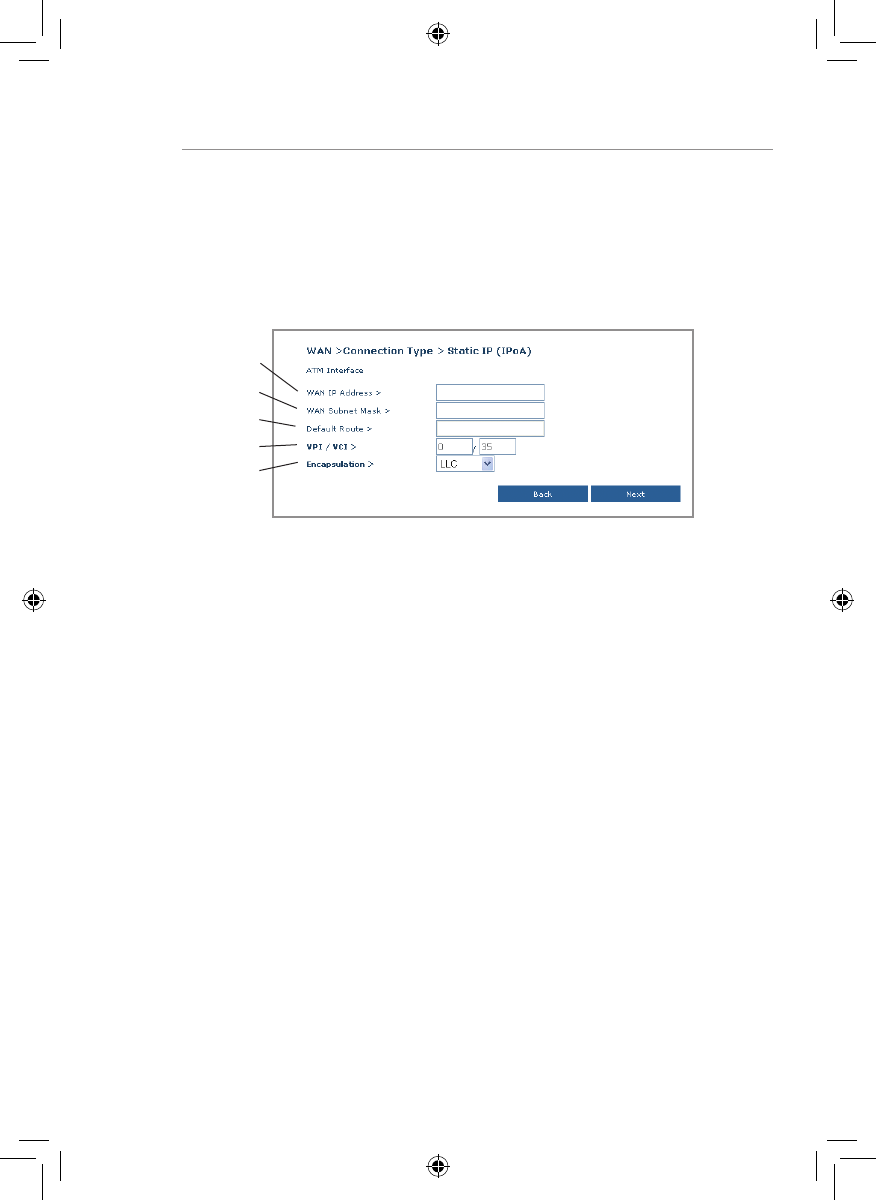
3534
Manually Configuring your Router
35
Manually Configuring your Router
Setting your ISP Connection to Static IP (IPoA)
This connection type is also called “Classical IP over ATM” or “CLIP”,
which your ISP provides a fixed IP for your Router to connect to
the Internet.
1. WAN IP Address – Enter an IP address assigned by your ISP for
the Router WAN interface.
2. WAN Subnet Mask - Enter a subnet mask assigned by your ISP.
3. Default Route - Enter a default gateway IP address. If the Router
cannot find the destination address within its local network, it will
forward the packets to the default gateway assigned by your ISP.
4. VPI/VCI - Enter your Virtual Path Identifier (VPI) and Virtual Circuit
Identifier (VCI) parameter here. These identifiers are assigned by
your ISP.
5. Encapsulation - Select LLC or VC MUX your ISP uses.
(1)
(2)
(3)
(4)
(5)
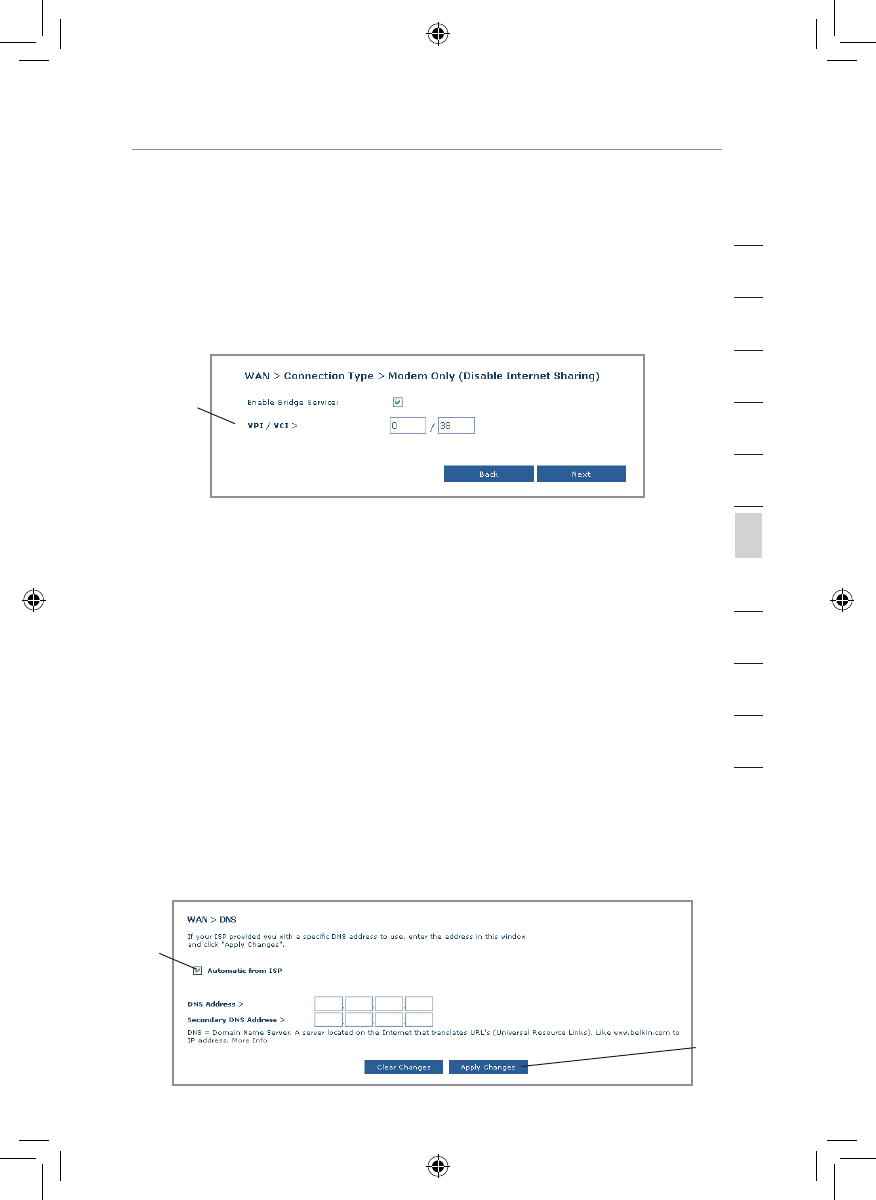
3534
Manually Configuring your Router
Manually Configuring your Router
35
Manually Configuring your Router
section
2
1
3
4
5
6
7
8
9
10
11
12
Setting your Connection Type to Modem Only (Disable
Internet Sharing)
In this mode, the Router simply acts as a bridge passing packets
across the DSL port. It requires additional software to be installed on
your computers in order to access the Internet.
1. VPI/VCI - Enter your Virtual Path Identifier (VPI) and Virtual Circuit
Identifier (VCI) parameter here. (Assigned by your ISP).
2. Encapsulation - Select LLC or VC MUX. (Assigned by your ISP).
DNS (Domain Name Server) Settings
A “Domain Name Server” is a server located on the Internet that
translates Universal Resource Links (URLs) like “www.belkin.com” to
IP addresses. Many ISPs do not require you to enter this information
into the Router. The “Automatic from ISP” box (1) should be checked
if your ISP did not give you a specific DNS address. If you are using
a static IP connection type, then you may need to enter a specific
DNS address and secondary DNS address for your connection to work
properly. If your connection type is dynamic or PPPoE, it is likely that
you do not have to enter a DNS address. Leave the “Automatic from
ISP” box checked. To enter the DNS address settings, uncheck the
“Automatic from ISP” box and enter your DNS entries in the spaces
provided. Click “Apply Changes” (2) to save the settings.
(1)
(2)
(1)
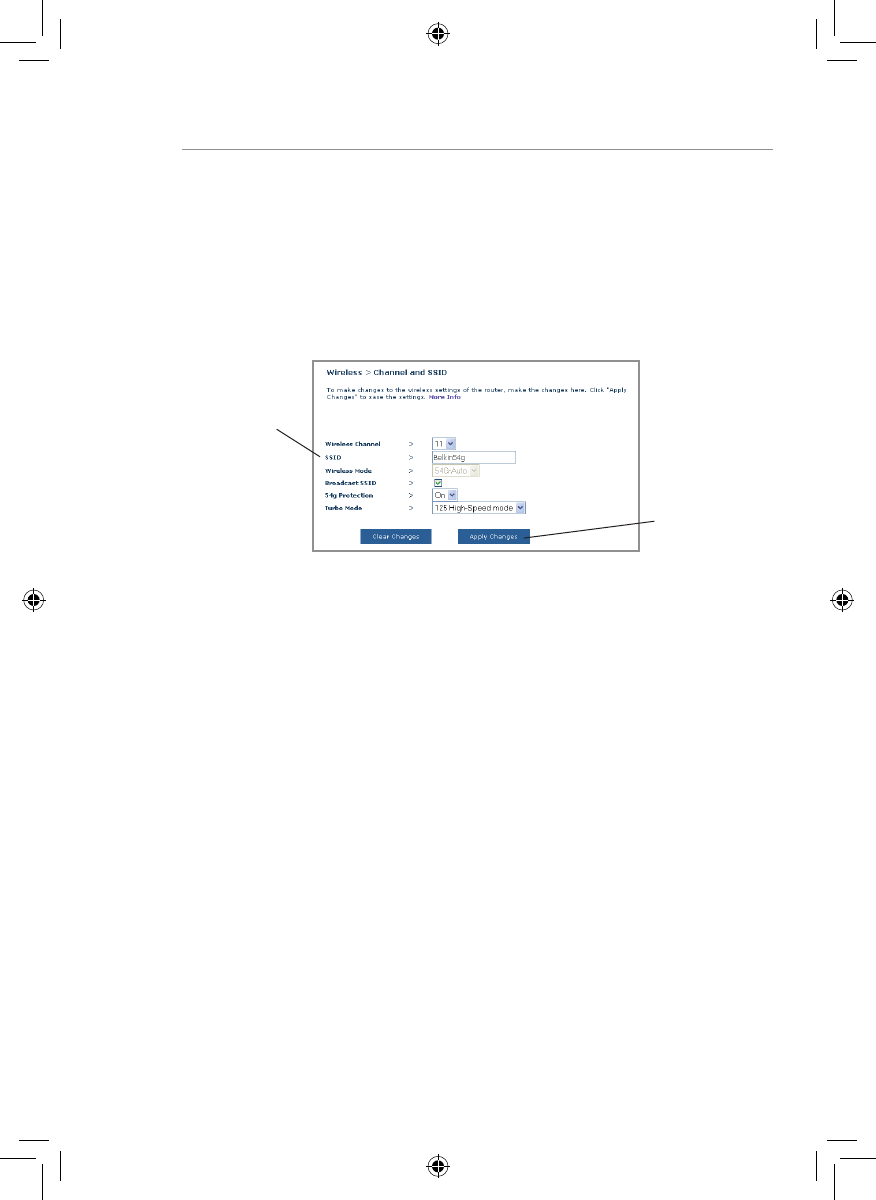
3736
Manually Configuring your Router
37
Manually Configuring your Router
Wireless
The “Wireless” tab lets you make changes to the wireless network
settings. From this tab, you can make changes to the wireless network
name (SSID), operating channel, and encryption security settings.
Channel and SSID
1. Changing the Wireless Channel
There are a number of operating channels you can choose from.
In the United States, there are 11 channels. In the United Kingdom
and most of Europe, there are 13 channels. In a small number of
other countries, there are other channel requirements. Your Router
is configured to operate on the proper channels for the country you
reside in. The default channel is 11 (unless you are in a country that
does not allow channel 11). The channel can be changed if needed. If
there are other wireless networks operating in your area, your network
should be set to operate on a channel that is different than the other
wireless networks. For best performance, use a channel that is at least
five channels away from the other wireless networks. For instance, if
another network is operating on channel 11, then set your network to
channel 6 or below. To change the channel, select the channel from
the drop-down list. Click “Apply Changes”. The change is immediate.
2. Changing the Wireless Network Name (SSID)
To identify your wireless network, a name called the SSID (Service
Set Identifier) is used. The default SSID of the Router is “belkin54g”.
You can change this to anything you want to or you can leave it
unchanged. If there are other wireless networks operating in your
area, you will want to make sure that your SSID is unique (does not
match that of another wireless network in the area). To change the
SSID, type in the SSID that you want to use in the SSID field (1) and
click “Apply Changes” (2). The change is immediate. If you make
(1)
(2)

3736
Manually Configuring your Router
Manually Configuring your Router
37
Manually Configuring your Router
section
2
1
3
4
5
6
7
8
9
10
11
12
a change to the SSID, your wireless-equipped computers may also
need to be reconfigured to connect to your new network name. Refer
to the documentation of your wireless network adapter for information
on making this change.
3. Using the ESSID Broadcast Feature
For security purposes, you can choose not to broadcast your
network’s SSID. Doing so will keep your network name hidden from
computers that are scanning for the presence of wireless networks.
To turn off the broadcast of the SSID, select “DISABLE” and then
click “Apply Changes”. The change is immediate. Each computer
now needs to be set to connect to your specific SSID; an SSID of
“ANY” will no longer be accepted. Refer to the documentation of your
wireless network adapter for information on making this change.
Note: This advanced feature should be employed by advanced users only.
4. Using the Wireless Mode Switch
Your Router can operate in three different wireless modes:
“802.11g-Auto”, “802.11g-Only”, and “802.11g-LRS”. The different
modes are explained below.
• 802.11g-Auto - In this mode, the Router is compatible with
802.11b and 802.11g wireless clients simultaneously. This is the
factory default mode and ensures successful operation with all
Wi-Fi-compatible devices. If you have a mix of 802.11b and
802.11g clients in your network, we recommend setting the Router
to 802.11g-Auto mode. This setting should only be changed if you
have a specific reason to do so.
• 802.11g-Only Mode - 802.11g-Only mode works with 802.11g
clients only. This mode is recommended only if you want to
prevent 802.11b clients from accessing your network. To switch
modes, select the desired mode from the “Wireless Mode”
drop-down box. Then, click “Apply Changes”.
• 802.11g-LRS Mode - We recommend you DO NOT use this
mode unless you have a very specific reason to do so. This mode
exists only to solve unique problems that may occur with some
802.11b client adapters and is NOT necessary for interoperability
of 802.11g and 802.11b standards.
When to Use 802.11g-LRS Mode - In some cases, older 802.11b
clients may not be compatible with 802.11g wireless technology.
These adapters tend to be of inferior design and may use older
drivers or technology. 802.11g-LRS (Limited Rate Support) allows

3938
Manually Configuring your Router
39
Manually Configuring your Router
these clients to be compatible with the newer 802.11g technology.
Switching to this mode can solve problems that sometimes occur
with these clients. If you suspect that you are using a client adapter
that falls into this category, first check with the adapter vendor to
see if there is a driver update. If there is no driver update available,
switching to 802.11g-LRS mode may fix your problem. Please note
that switching to 802.11g-LRS mode may decrease 802.11g
performance slightly.
5. Protected Mode Switch
As part of the 802.11g specification, Protected mode ensures proper
operation of 802.11g clients and access points when there is heavy
802.11b traffic in the operating environment. When Protected mode
is ON, 802.11g scans for other wireless network traffic before it
transmits data. Therefore, using this mode in environments with
HEAVY 802.11b traffic or interference achieves best performance
results. If you are in an environment with very little—or no—wireless
network traffic, your best performance will be achieved with Protected
mode OFF.
6. Using High-Speed Mode
The Router supports two high-speed modes: 125HSM* (High-Speed
Mode) and Frame Bursting. Selecting “125HSM Mode” will result in
all devices running in 125HSM if all devices are capable of 125Mbps
speeds. If any non-125HSM device connects or associates with the
network, the Router will automatically shift the entire network back to
Frame Bursting mode.
Selecting “Frame Bursting Mode” will result in all devices capable of
Frame Bursting to function in Frame Bursting mode, and all clients
not capable, to operate in normal 802.11g modes. Frame Bursting
mode supports both Frame Bursting-enabled devices and non-Frame
Bursting-enabled devices simultaneously. Frame Bursting mode is
based on the unreleased 802.11e specification.
Selecting “Off” will disable Turbo mode.
*When operating in High-Speed Mode, this Wi-Fi device may achieve
an actual throughput of up to or greater than 34.1Mbps, which is the
equivalent throughput of a system following 802.11g protocol and
operating at a signaling rate of 125Mbps. Actual throughput will vary
depending on environmental operational and other factors.

3938
Manually Configuring your Router
Manually Configuring your Router
39
Manually Configuring your Router
section
2
1
3
4
5
6
7
8
9
10
11
12
Encryption/Security
Securing your Wi-Fi Network
Here are a few different ways you can maximize the security of your
wireless network and protect your data from prying eyes and ears.
This section is intended for the home, home office, and small office
user. At the time of this User Manual’s publication, there are three
encryption methods available.
Name 64-bit Wired
Equivalent
Privacy
128-bit Wired
Equivalent
Privacy
Wi-Fi Protected
Access-TKIP With Protected
Access
Acronym 64-bit WEP 128-bit WEP WPA-TKIP WPA-AES
Security Good Better Best Best
Features Static keys Static keys Dynamic key
encryption
and mutual
authentication.
Dynamic key
encryption
and mutual
authentication.
Encryption
keys based
on RC4
algorithm
(typically
40-bit keys)
More secure
than 64-bit
WEP using a
key length of
104 bits plus
24 additional
bits of system
generated
data.
TKIP (temporal
key integrity
protocol)
added so
that keys are
rotated and
encryption is
strengthened.
AES (Advanced
Encryption
Standard) does
not cause any
throughput
loss.
WEP (Wired Equivalent Privacy)
WEP is a common protocol that adds security to all Wi-Fi-compliant
wireless products. WEP was designed to give wireless networks the
equivalent level of privacy protection as a comparable wired network.
64-Bit WEP
64-bit WEP was first introduced with 64-bit encryption, which includes
a key length of 40 bits plus 24 additional bits of system-generated
data (64 bits total). Some hardware manufacturers refer to 64-bit
as 40-bit encryption. Shortly after the technology was introduced,
researchers found that 64-bit encryption was too easy to decode.

4140
Manually Configuring your Router
41
Manually Configuring your Router
128-Bit WEP
As a result of 64-bit WEP’s potential security weaknesses, a more
secure method of 128-bit encryption was developed. 128-bit
encryption includes a key length of 104 bits plus 24 additional bits of
system-generated data (128 bits total). Some hardware manufacturers
refer to 128-bit as 104-bit encryption.
Most of the new wireless equipment in the market today supports
both 64-bit and 128-bit WEP encryption, but you might have older
equipment that only supports 64-bit WEP. All Belkin wireless products
will support both 64-bit and 128-bit WEP.
Encryption Keys
After selecting either the “64-bit” or “128-bit WEP” encryption mode,
it is critical that you generate an encryption key. If the encryption key
is not consistent throughout the entire wireless network, your wireless
networking devices will be unable to communicate with one another
on your network and you will not be able to successfully communicate
within your network.
You can enter your key by typing in the hex key manually, or you can
type in a passphrase in the “Passphrase” field and click “Generate”
to create a key. A hex (hexadecimal) key is a mixture of numbers and
letters from A–F and 0–9. For 64-bit WEP, you need to enter 10 hex
keys. For 128-bit WEP, you need to enter 26 hex keys.
For instance:
AF 0F 4B C3 D4 = 64-bit WEP key
C3 03 0F AF 0F 4B B2 C3 D4 4B C3 D4 E7 = 128-bit WEP key
The WEP passphrase is NOT the same as a WEP key. Your wireless
card uses this passphrase to generate your WEP keys, but different
hardware manufacturers might have different methods for generating
the keys. If you have equipment from multiple vendors in your
network, you can use the hex WEP key from your Router or access
point and enter it manually into the hex WEP key table in your
wireless card’s configuration screen.

4140
Manually Configuring your Router
Manually Configuring your Router
41
Manually Configuring your Router
section
2
1
3
4
5
6
7
8
9
10
11
12
WPA (Wi-Fi Protected Access)
WPA (Wi-Fi Protected Access) is a new Wi-Fi standard that was
designed to improve upon the security features of WEP. To use WPA
security, the drivers and software of your wireless equipment must
be upgraded to support WPA. These updates will be found on the
wireless vendors’ websites. There are two types of WPA security:
WPA-PSK (no server) and WPA (with radius server).
WPA-PSK (no server)
This method uses what is known as a Pre-Shared key as the Network
key. A Network key is basically a password that is between eight
and 63 characters long. It can be a combination of letters, numbers,
or characters. Each client uses the same Network key to access the
network. Typically, this is the mode that will be used in a
home environment.
WPA (with radius server)
With this system, a radius server distributes the Network key to
the clients automatically. This is typically found in a business
environment. For a list of Belkin wireless products that support WPA,
please visit our website at www.belkin.com/networking.
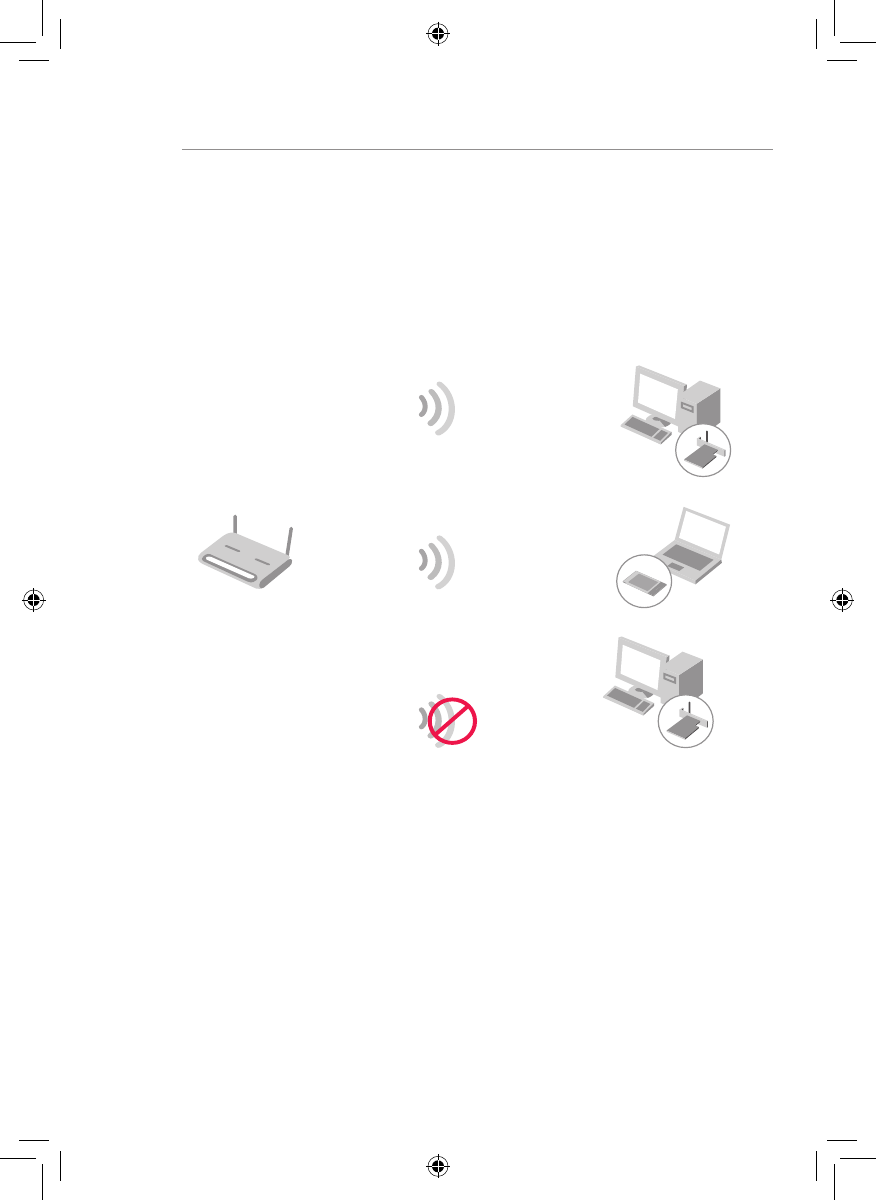
4342
Manually Configuring your Router
43
Manually Configuring your Router
Sharing the Same Network Keys
Most Wi-Fi products ship with security turned off. So once you have
your network working, you need to activate WEP or WPA and make
sure your wireless networking devices are sharing the same
Network key.
The Wireless G Desktop Network Card cannot access the network
because it is using a different Network key than the Network key that
is configured on the Wireless G Router.
Wireless G Router
Wireless G Notebook
Network Card
Wireless G Desktop
Network Card
Wireless G Desktop
Network Card
Network key=
WRONG Password
Network key=
MyPassword
Network key=
MyPassword
Network key=
MyPassword
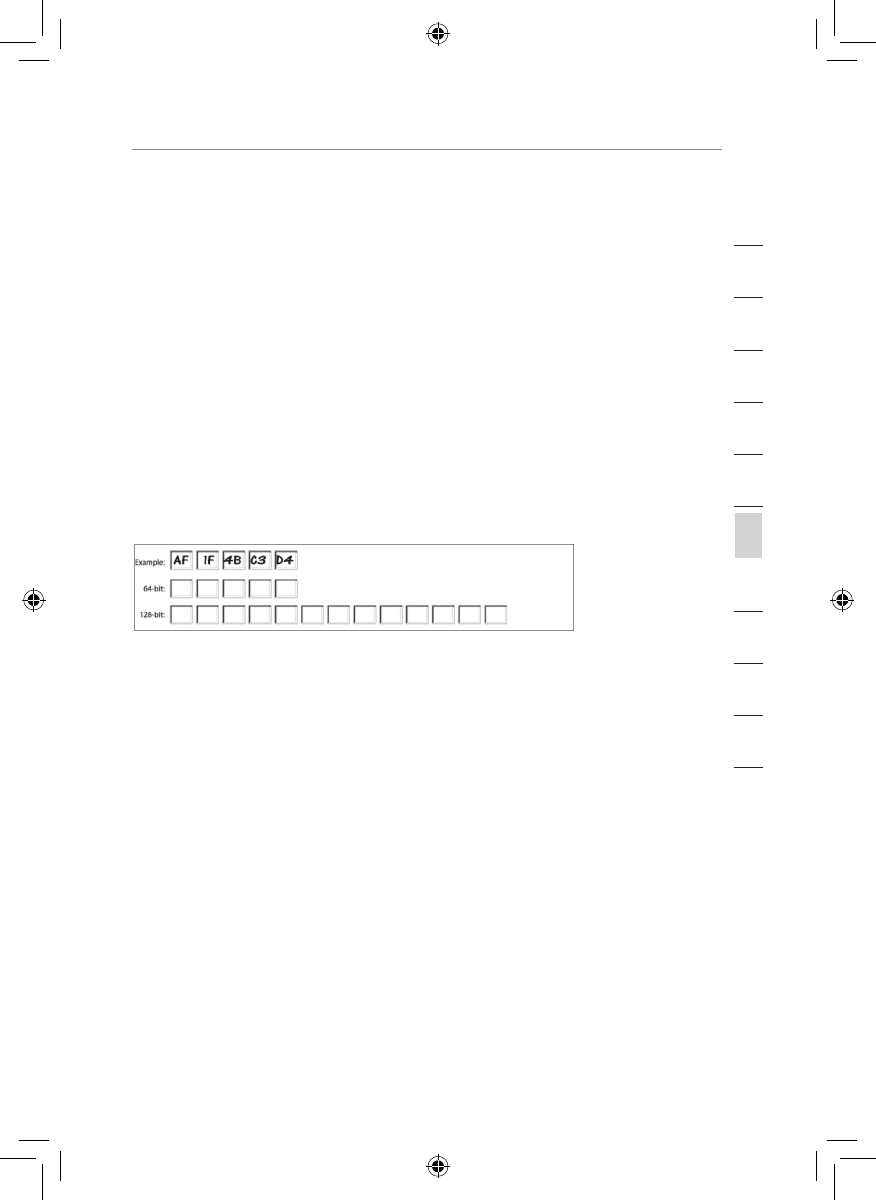
4342
Manually Configuring your Router
Manually Configuring your Router
43
Manually Configuring your Router
section
2
1
3
4
5
6
7
8
9
10
11
12
Using a Hexadecimal Key
A hexadecimal key is a mixture of numbers and letters from A–F and
0–9. 64-bit keys are five two-digit numbers. 128-bit keys are 13
two-digit numbers.
For instance:
AF 0F 4B C3 D4 = 64-bit key
C3 03 0F AF 0F 4B B2 C3 D4 4B C3 D4 E7 = 128-bit key
In the boxes below, make up your key by writing in two characters
between A–F and 0–9 in each box. You will use this key to program
the encryption settings on your Router and your wireless computers.
Note to Mac users: Original Apple AirPort® products support
64-bit encryption only. Apple AirPort 2 products can support 64-bit or
128-bit encryption. Please check your product to see which version
you are using. If you cannot configure your network with 128-bit
encryption, try 64-bit encryption.

4544
Manually Configuring your Router
45
Manually Configuring your Router
WEP Setup
64-Bit WEP Encryption
1. Select “64-bit WEP” from the drop-down menu.
2. After selecting your WEP encryption mode, you can enter your key
by typing in the hex key manually.
A hex (hexadecimal) key is a mixture of numbers and letters from A–F
and 0–9. For 64-bit WEP, you need to enter 10 hex keys.
For instance:
AF 0F 4B C3 D4 = 64-bit WEP key
3. Click “Apply Changes” to finish. Encryption in the Router is now
set. Each of your computers on your wireless network will now
need to be configured with the same security settings.
WARNING: If you are configuring the Wireless Router or access point
from a computer with a wireless client, you will need to ensure that
security is turned ON for this wireless client. If this is not done, you
will lose your wireless connection.
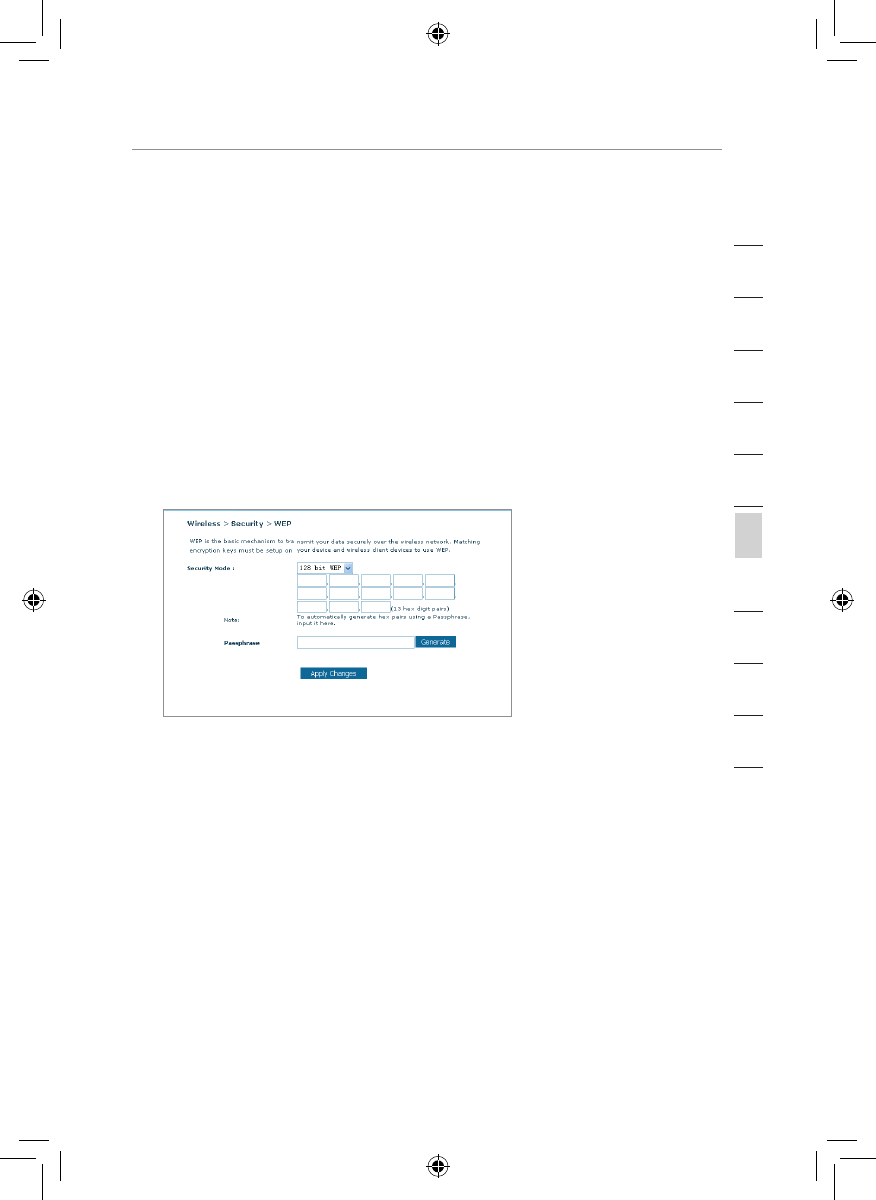
4544
Manually Configuring your Router
Manually Configuring your Router
45
Manually Configuring your Router
section
2
1
3
4
5
6
7
8
9
10
11
12
128-Bit WEP Encryption
1. Select “128-bit WEP” from the drop-down menu.
2. After selecting your WEP encryption mode, you can enter your
key manually by typing in the hex key manually.
A hex (hexadecimal) key is a mixture of numbers and letters from
A–F and 0–9. For 128-bit WEP, you need to enter 26 hex keys.
For instance:
C3 03 0F AF 0F 4B B2 C3 D4 4B C3 D4 E7 = 128-bit WEP key
3. Click “Apply Changes” to finish. Encryption in the Router is now
set. Each of your computers on your wireless network will now
need to be configured with the same security settings.
WARNING: If you are configuring the Wireless Router or access point
from a computer with a wireless client, you will need to ensure that
security is turned ON for this wireless client. If this is not done, you
will lose your wireless connection.

4746
Manually Configuring your Router
47
Manually Configuring your Router
Changing the Wireless Security Settings
Your Router is equipped with WPA (Wi-Fi Protected Access), the
latest wireless security standard. It also supports the legacy security
standard, WEP (Wired Equivalent Privacy). By default, wireless
security is disabled. To enable security, you must first determine
which standard you want to use. To access the security settings, click
“Security” on the Wireless tab.
WPA Setup
Note: To use WPA security, all your clients must be upgraded
to drivers and software that support it. At the time of this User
Manual’s publication, a security patch download is available free
from Microsoft. This patch works only with the Windows XP operating
system. You also need to download the latest driver for your Belkin
Wireless G Desktop or Notebook Network Card from the Belkin
support site. Other operating systems are not supported at this time.
Microsoft’s patch only supports devices with WPA-enabled drivers
such as Belkin 802.11g products.
There are two types of WPA security: WPA-PSK (no server) and WPA
(with radius server). WPA-PSK (no server) uses a so-called
Pre-Shared key as the security key. A Pre-Shared key is a password
that is between eight and 63 characters long. It can be a combination
of letters, numbers, and other characters. Each client uses the same
key to access the network. Typically, this mode will be used in a
home environment.
WPA (with radius server) is a configuration wherein a radius server
distributes the keys to the clients automatically. This is typically used
in a business environment.
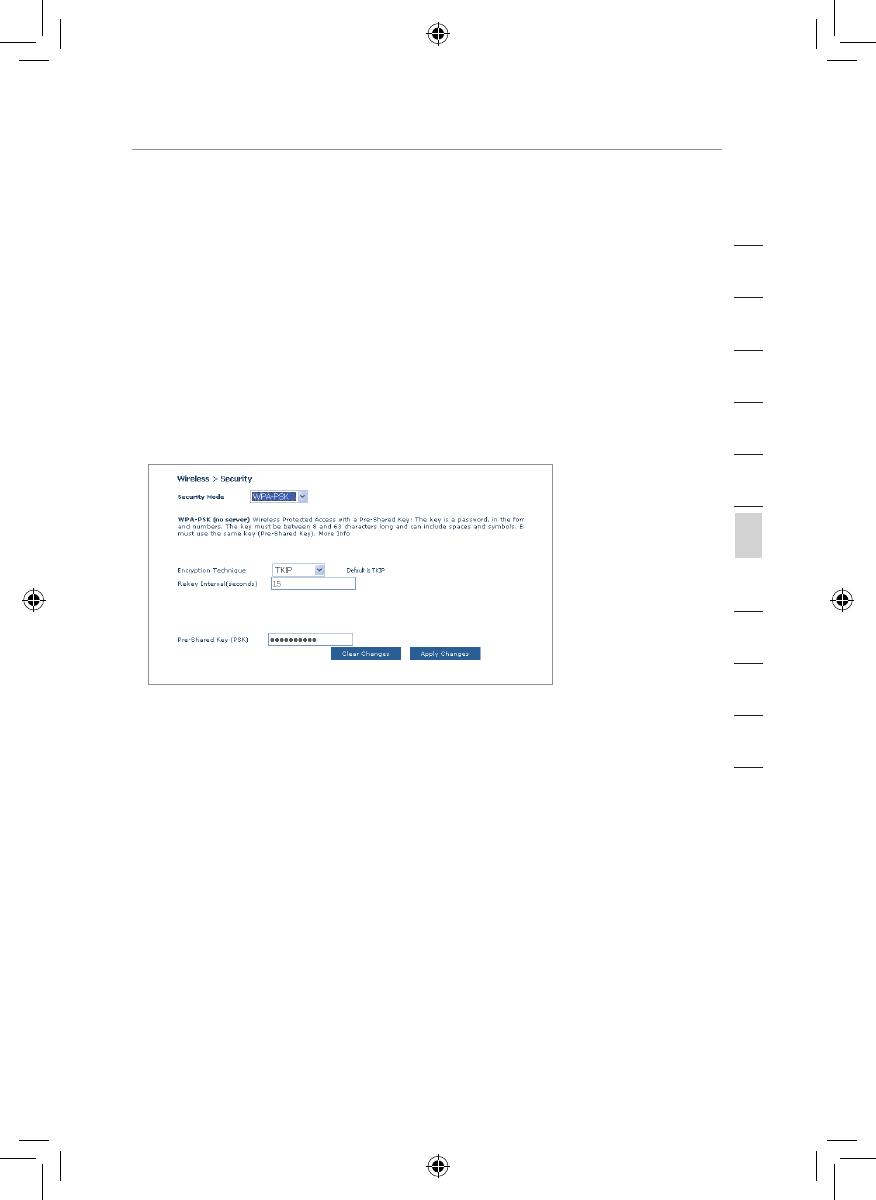
4746
Manually Configuring your Router
Manually Configuring your Router
47
Manually Configuring your Router
section
2
1
3
4
5
6
7
8
9
10
11
12
Setting WPA-PSK (no server)
1.
From the “Security Mode” drop-down menu, select “WPA-PSK
(no server)”.
2. For Encryption Technique, select “TKIP” or “AES”. This setting will
have to be identical on the clients that you set up.
3. Enter your Pre-Shared key. This can be from eight to 63 characters
and can be letters, numbers, or symbols. This same key must be
used on all of the clients that you set up. For example, your PSK
might be something like: “Smith family network key”.
4. Click “Apply Changes” to finish. You must now set all clients to
match these settings.
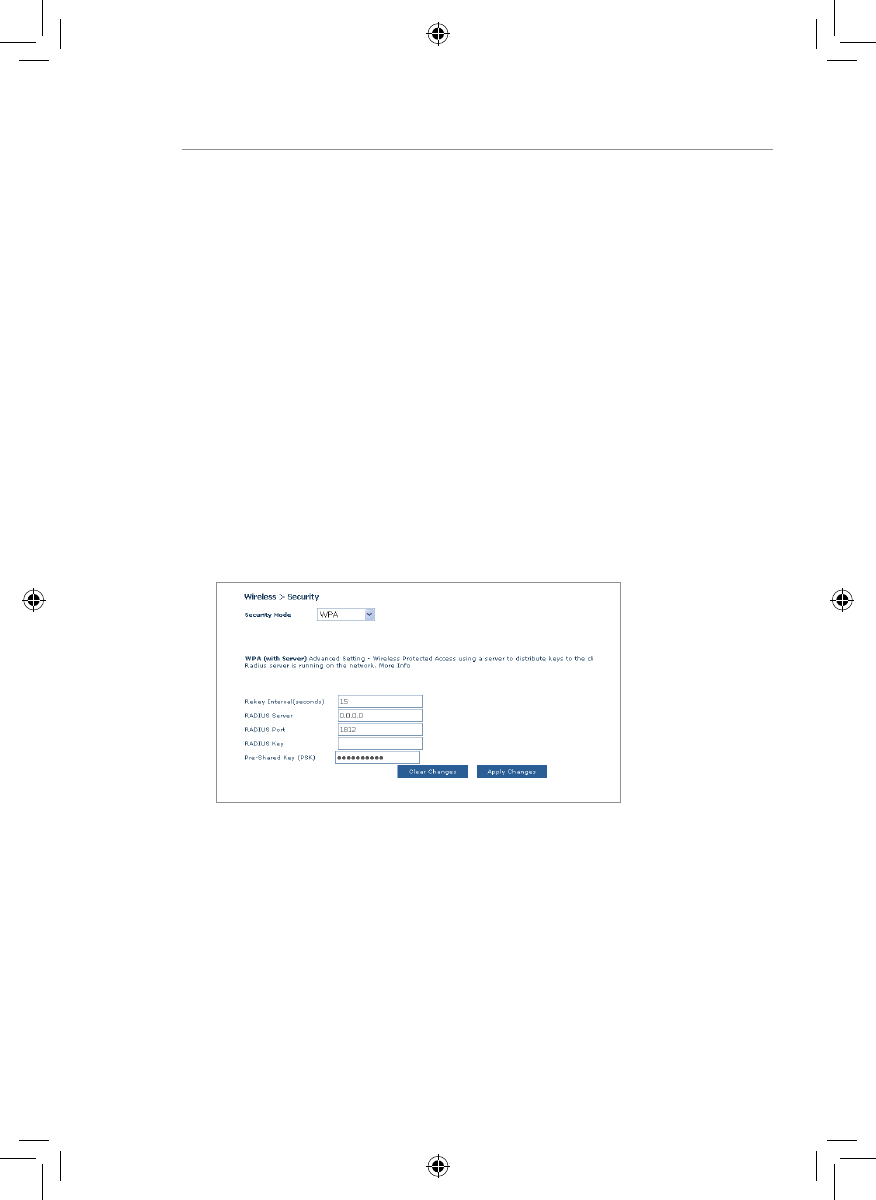
4948
Manually Configuring your Router
49
Manually Configuring your Router
Setting WPA (with radius server) Settings
If your network uses a radius server to distribute keys to the clients,
use this setting.
1. From the “Security Mode” drop-down menu, select
“WPA—Radius server)”.
2. For Encryption Technique, select “TKIP” or “AES”. This setting
will have to be identical on the clients that you set up
3. Enter the IP address of the radius server into the “Radius
Server” fields.
4. Enter the radius key into the “Radius Key” field.
5. Enter the key interval. Key interval is how often the keys are
distributed (in packets).
6. Click “Apply Changes” to finish. You must now set all clients to
match these settings.
Configuring your Belkin Wireless G Network Cards to
Use Security
Please Note: This section provides information on how to configure
your Belkin Wireless G Network Cards to use security.
At this point, you should already have your Wireless Router or access
point set to use WPA or WEP. In order for you to gain a wireless
connection, you will need to set your wireless notebook card and
wireless desktop card to use the same security settings.
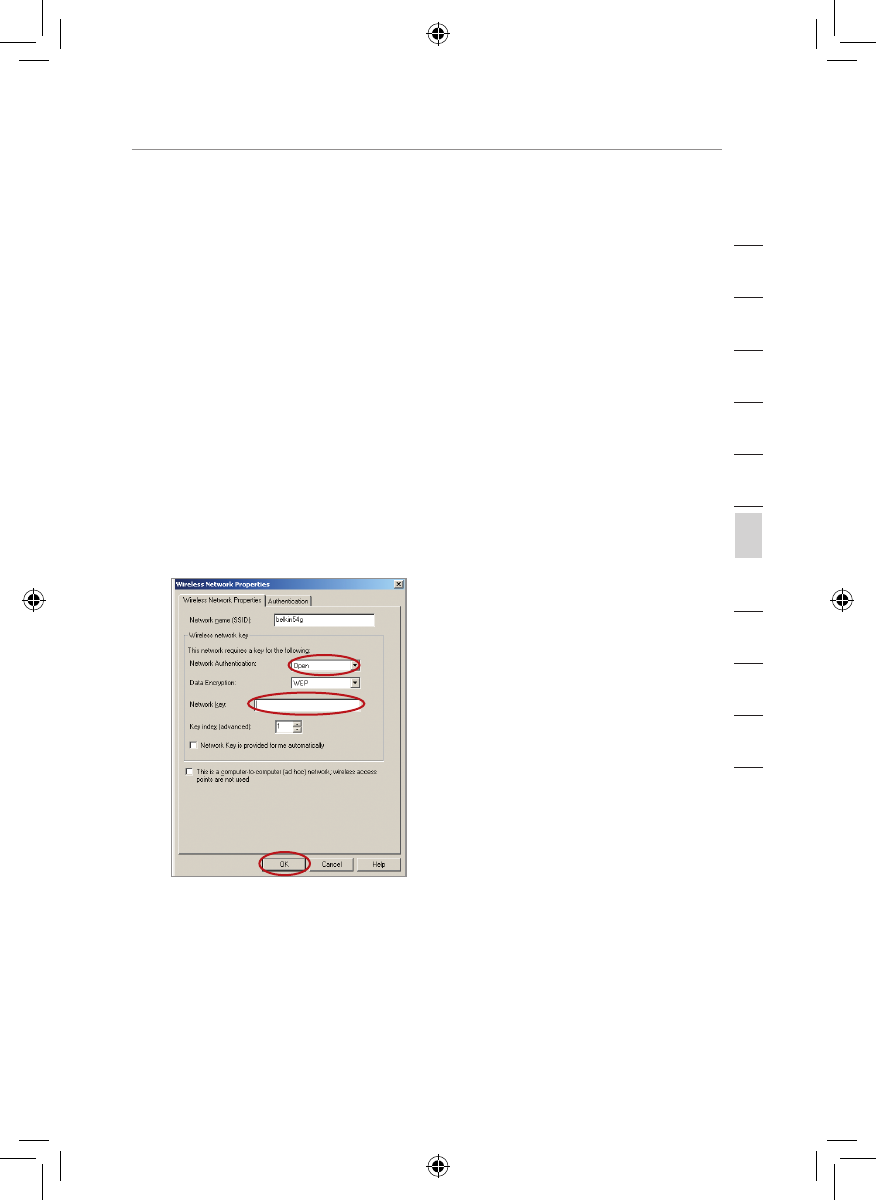
4948
Manually Configuring your Router
Manually Configuring your Router
49
Manually Configuring your Router
section
2
1
3
4
5
6
7
8
9
10
11
12
Connecting your Computer to a Wireless Network that Requires a
64-Bit or 128-Bit WEP Key
1. Double-click the “Signal Indicator” icon to bring up the “Wireless
Network” screen. The “Advanced” button will allow you to view
and configure more options of your wireless card.
2. Under the “Wireless Network Properties” tab, select a network
name from the “Available networks” list and click “Configure”.
3. Under “Data Encryption” select “WEP”.
4. Ensure the check box “Network key is provided for me
automatically” at the bottom is unchecked. If you are using this
computer to connect to a corporate network, please consult your
network administrator if this box needs to be checked.
5. Type your WEP key in the “Network key” box.
Important: A WEP key is a mixture of numbers and letters from A–F
and 0–9. For 128-bit WEP, you need to enter 26 keys. For 64-bit WEP,
you need to enter 10 keys. This Network key needs to match the key
you assign to your Wireless Router or access point.
6. Click “OK” to save the settings.
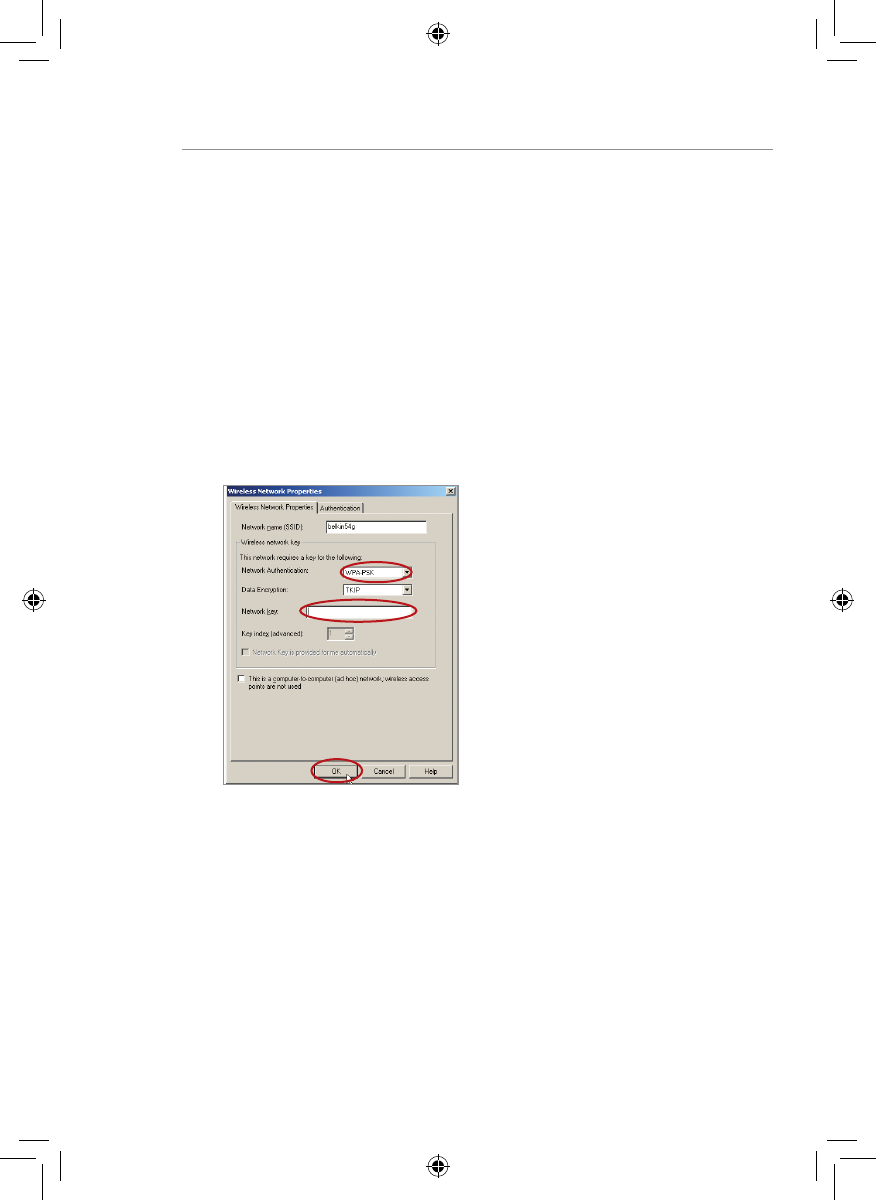
5150
Manually Configuring your Router
51
Manually Configuring your Router
Connecting your Computer to a Wireless Network that Requires
WPA-PSK (no server)
1. Double-click the “Signal Indicator” icon to bring up the “Wireless
Network” screen. The “Advanced” button will allow you to view
and configure more options of your wireless card.
2. Under the “Wireless Networks” tab, select a network name from
the “Available networks” list and click “Configure”.
3. Under “Network Authentication” select “WPA-PSK (No Server)”.
4. Type your WPA key in the “Network key” box.
Important: WPA-PSK is a mixture of numbers and letters from A–Z
and 0–9. For WPA-PSK you can enter eight to 63 keys. This Network
key needs to match the key you assign to your Wireless Router or
access point.
5. Click “OK” to save the settings.